Paul van Yperen's Blog, page 272
May 12, 2018
Rare vintage postcards from the Collection of Didier Hanson
At our Flickr site Truus, Bob and Jan Too!, we have an album with rare vintage postcards from the collection of Didier Hanson. Once in a while Didier sends us scans of his postcards which we upload and add to this ever growing album. Just take a look and enjoy. Some of his cards are rare and amazing. Museum curators mail us with questions about them. Didier recently sent us again some unknown postcards from the burgeoning cinema of the Russian Empire, just before the October Revolution. We post them today with some other Russian cards of his collection. I guess nobody else has so much postcards of Vera Kholodnaya as Didier. 'But finding postcards of interest for me becomes almost "mission impossible"', Didier confessed in a recent mail. Didier, we'll keep hope, pray, and say: 'thanks, pal!'
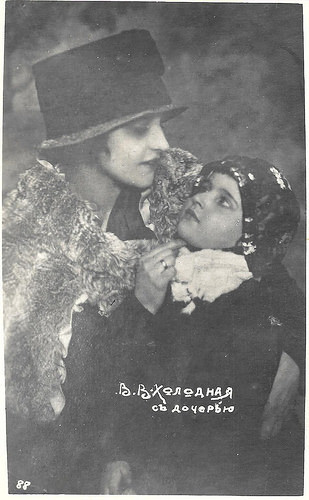
Vera Kholodnaya . Russian postcard, no. 88. Collection: Didier Hanson.
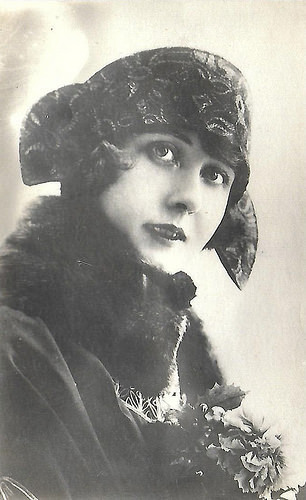
Vera Kholodnaya . Russian postcard, no. 131, 1914. Collection: Didier Hanson.
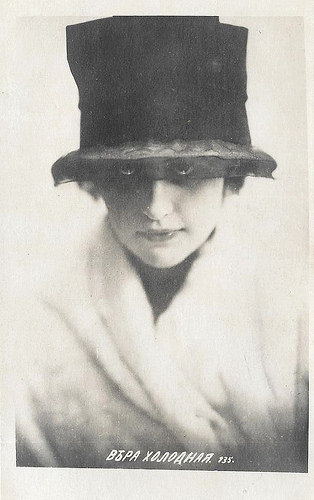
Vera Kholodnaya . Russian postcard, no. 135. Collection: Didier Hanson.
Vera Kholodnaya (1893-1919) was the first star of the Russian silent cinema. Only 26, the ‘Queen of Screen’ died of the Spanish flu during the pandemic of 1919. Although she worked only three years for the cinema, she must have made some forty short and feature films. The Soviet authorities ordered to destroy many of the Kholodnaya features in 1924, and only five of her films still exist.
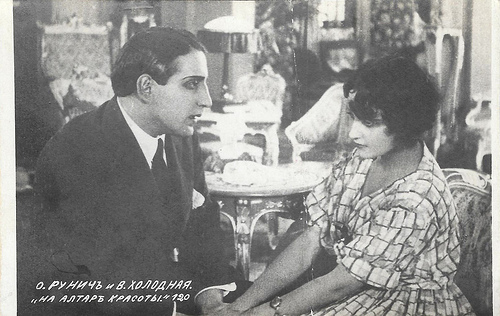
Ossip Runitsch and Vera Kholodnaya in Na altar krasoty (1917). Russian postcard, no. 120. Photo: publicity still for Na altar krasoty/To the Altar of Beauty (Pyotr Chardynin, 1917). Collection: Didier Hanson.
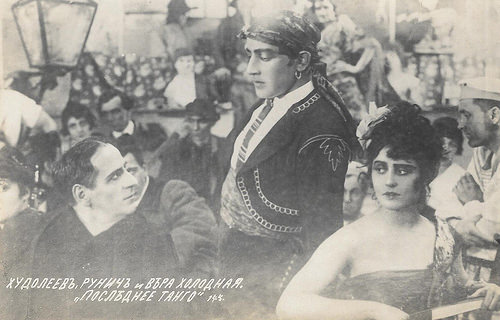
Ivan Khudoleyev, Ossip Runitsch and Vera Kholodnaya in Posledneiye tango (1918). Russian postcard, no. 145. Photo: publicity still for Posledneiye tango/Last Tango (Vyacheslav Viskovsky, 1918). Collection: Didier Hanson.
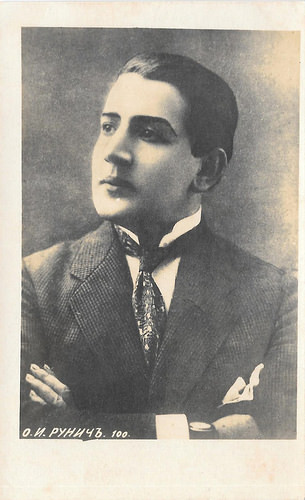
Ossip Runitsch . Russian postcard, no. 100. Collection: Didier Hanson.
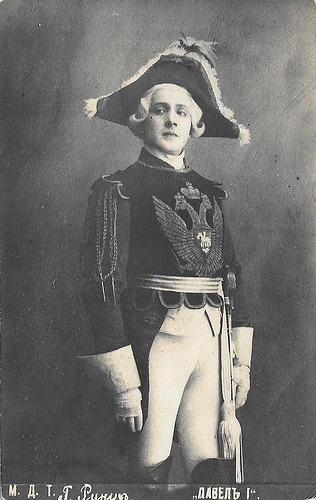
Ossip Runitsch . Russian postcard. Collection: Didier Hanson.
Russian actor, producer and stage director Ossip Runitsch (1889-1947) was one of the biggest stars of the Russian silent film and one of the first iconic figures of the early Russian cinema. After the October revolution, he worked in Latvia, Italy, Germany, France and South-Africa.
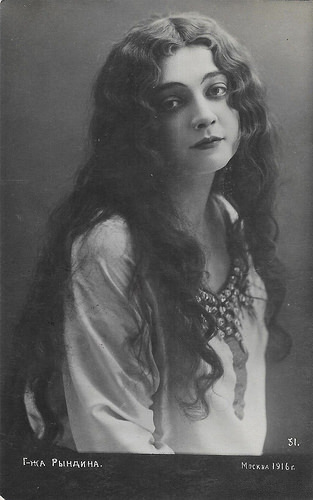
Lidiya Ryndina , 1916. Russian Postcard. Collection: Didier Hanson.
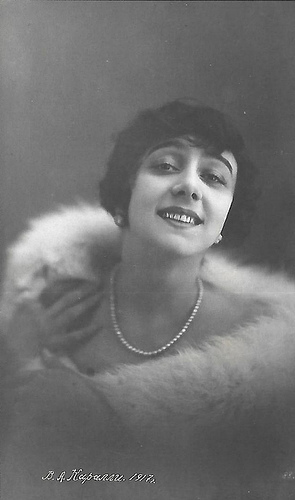
Vera Karalli , 1917. Russian postcard. Collection: Didier Hanson.
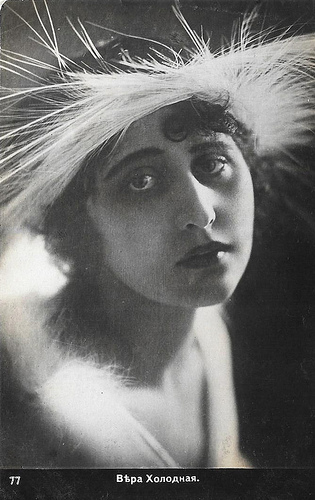
Vera Kholodnaya . Russian postcard, no. 77. Collection: Didier Hanson.

Vera Kholodnaya . Russian postcard, no. 88. Collection: Didier Hanson.

Vera Kholodnaya . Russian postcard, no. 131, 1914. Collection: Didier Hanson.

Vera Kholodnaya . Russian postcard, no. 135. Collection: Didier Hanson.
Vera Kholodnaya (1893-1919) was the first star of the Russian silent cinema. Only 26, the ‘Queen of Screen’ died of the Spanish flu during the pandemic of 1919. Although she worked only three years for the cinema, she must have made some forty short and feature films. The Soviet authorities ordered to destroy many of the Kholodnaya features in 1924, and only five of her films still exist.

Ossip Runitsch and Vera Kholodnaya in Na altar krasoty (1917). Russian postcard, no. 120. Photo: publicity still for Na altar krasoty/To the Altar of Beauty (Pyotr Chardynin, 1917). Collection: Didier Hanson.

Ivan Khudoleyev, Ossip Runitsch and Vera Kholodnaya in Posledneiye tango (1918). Russian postcard, no. 145. Photo: publicity still for Posledneiye tango/Last Tango (Vyacheslav Viskovsky, 1918). Collection: Didier Hanson.

Ossip Runitsch . Russian postcard, no. 100. Collection: Didier Hanson.

Ossip Runitsch . Russian postcard. Collection: Didier Hanson.
Russian actor, producer and stage director Ossip Runitsch (1889-1947) was one of the biggest stars of the Russian silent film and one of the first iconic figures of the early Russian cinema. After the October revolution, he worked in Latvia, Italy, Germany, France and South-Africa.

Lidiya Ryndina , 1916. Russian Postcard. Collection: Didier Hanson.

Vera Karalli , 1917. Russian postcard. Collection: Didier Hanson.

Vera Kholodnaya . Russian postcard, no. 77. Collection: Didier Hanson.
Published on May 12, 2018 22:00
May 10, 2018
Ed. A Traldi
Some of our most beautiful Italian postcards were published by Ed. A. Traldi. Traldi operated in Milan from 1902 on. The publisher concentrated on view cards of Europe and the Middle East. They are also known for a series published that focused on dogs. But we are most interested in the postcard portraits of European stage and film performers, and the cards with stills of silent films of the 1920s, often distributed by Pittaluga Films. After World War II, Ed. A. Traldi returned as Vetta Traldi with pin-up postcards and with the Divi del Cinema series.
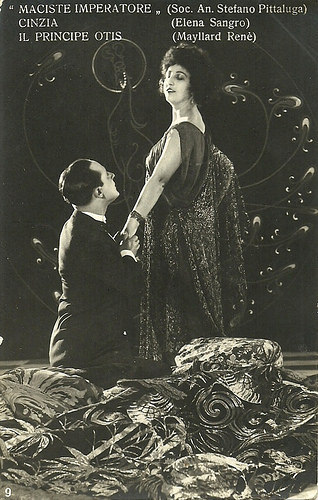
Italian postcard by Ed. A. Traldi, Milano, no. 9. Photo: Pittaluga. Publicity still of Elena Sangro as Cinzia and René [Raoul] Mayllard as prince Otis [Ortis] in the Fert production Maciste imperatore/Emperor Maciste (Guido Brignone, 1924).
Maciste imperatore (1924) was part of the popular Maciste series of films starring Bartolomeo Pagano as the strongman Maciste. In the kingdom of Sindagna, the prince regent Stanos tries with all means to dispose of the legitime heir to the throne, prince Ortis. When Maciste and his companion Saetta happen to be in the chaotic empire, they set things straight for the poor, weak prince. Maciste is proclaimed emperor of Sindagna after getting rid of the regent and his puppet ruler, restores peace, and arranges that the prince can also be united with his beloved one. The plot line comes close Mussolini's take over of Italy, 'helping' the weak king Victor Emmanuel III and 'restoring order'.
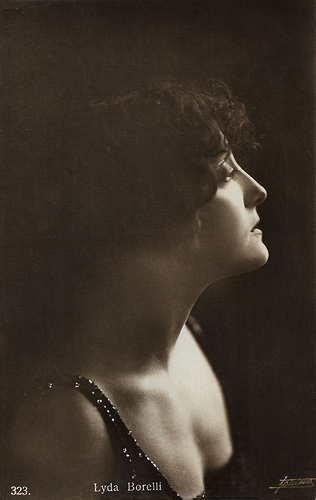
Italian postcard by Ed. A. Traldi, Milano, no. 323. Photo: Fontana.
Considering her profile, it is not hard to imagine why critics and artists of the early 20th century compared stage and film diva Lyda Borelli (1887-1959) to the heroines of Aubrey Beardsley.
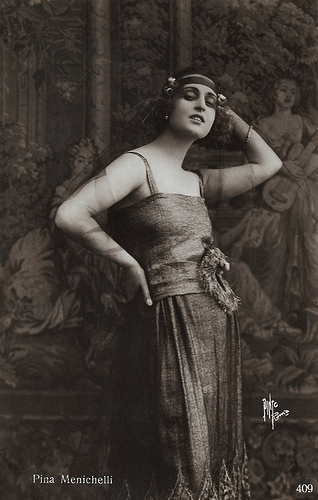
Italian postcard by Ed. A. Traldi, Milano, no. 409. Photo: Pinto, Roma.
Pina Menichelli (1890-1984) was one of the Italian divas of the silent era. After starting her film career at the Roman Cines company in 1913, she was catapulted into stardom by Giovanni Pastrone's Dannunzian film Il Fuoco (1915). Because of her femme fatale, men devouring type and her extreme and sudden gestures she was nicknamed Notre Dame des Spasmes. Menichelli did however know how to play also in restrained ways, as her masterpiece Tigre Reale (Pastrone 1916) showed.
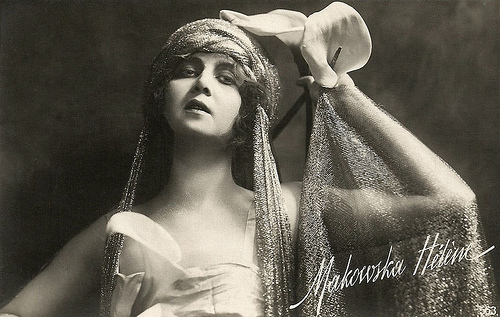
Italian postcard by Ed. A. Traldi, Milano, no. 563.
Polish singer and actress Helena Makowska aka Elena Makowska (1893-1964) was a beautiful diva of the Italian silent cinema in the 1910s. During the 1920s, she moved to Berlin and also became a star of the German cinema.
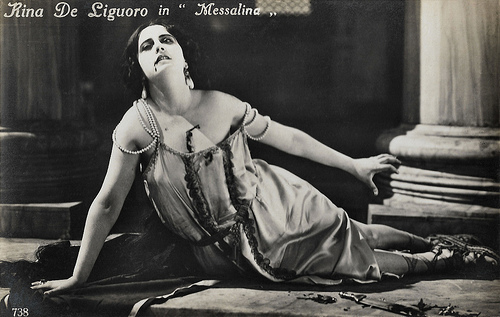
Italian postcard by Ed. A. Traldi, Milano, no. 738. Photo: publicity still of Rina De Liguoro dying in the final scene of Messalina (Enrico Guazzoni, 1924).
For diva Rina De Liguoro , the epic Messalina (1924) was the start of a prolific career in Italian silent cinema in the 1920s, with films like Quo vadis? (1924) and Gli ultimi giorni di Pompeii (1926). In the late 1920s she also performed in Germany and France, e.g. in Casanova (1927).
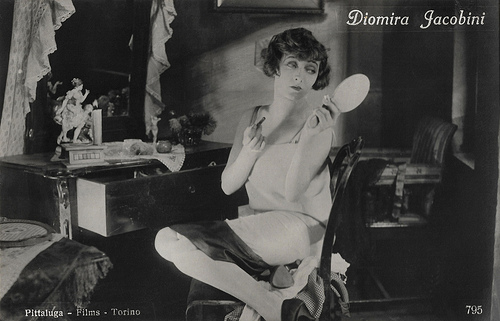
Italian postcard by Ed. Traldi, Milano, no. 795. Photo: Pittaluga Films, Torino.
Diomira Jacobini (1899-1959) was one of the stars of the Italian silent cinema. She was the younger sister of diva Maria Jacobini , in whose shadow she always stayed. Diomira appeared in some 55 films in Italy, Germany and Denmark.
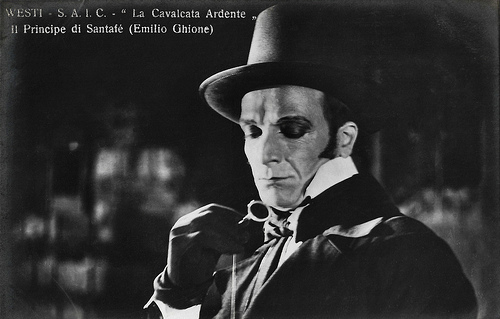
Italian postcard by Ed. A. Traldi, Milano. Photo: Westi SAIC. Publicity still for La cavalcata ardente (Carmine Gallone, 1925) with Emilio Ghione as the Prince of Santafé.
The highly successful film La cavalcata ardente (1925) was a melodrama set against the background of the conquest of Naples by Garibaldi's volunteers. Soava Gallone plays an aristocratic forced into marriage with an old prince ( Emilio Ghione ) but secretly in love with a patriot ( Gabriel de Gravone ).
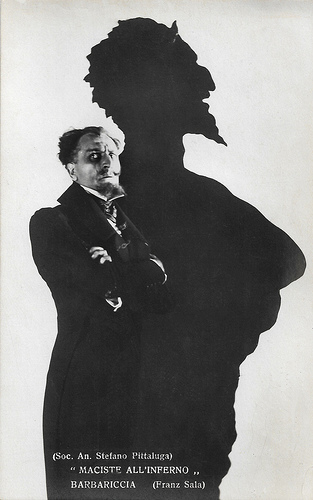
Italian postcard by Ed. A. Traldi, Milano. Photo: Soc. A. Stefano Pittaluga, Torino. Publicity still for Maciste all'inferno/Maciste in Hell (Guido Brignone, 1926), with Franz Sala as the devil Barbariccia.
Franz Sala aka Francesco Sala (1886-1952) was a prolific actor of the Italian silent cinema, mostly playing the evil antagonist.
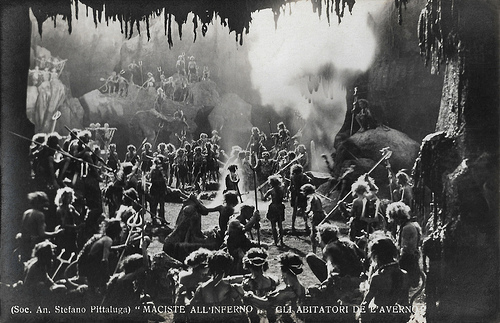
Italian postcard by Ed. A. Traldi, Milano. Photo: Pittaluga Films, Torino. Publicity still for Maciste all'inferno (Guido Brignone, 1926), starring Bartolomeo Pagano as Maciste. Caption: "The Inhabitants of the Underworld."
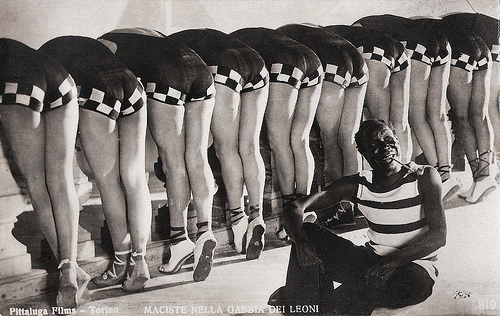
Italian postcard by Ed. A. Traldi, Milano, no. 819. Photo: Pittaluga Films, Torino. Publicity still for Maciste nella gabbia dei leoni/Maciste in the Lions' Cage (Guido Brignone, 1926).
Maciste nella gabbia dei leoni is an Italian silent adventure film directed by Guido Brignone for the Cinès-Pittaluga studio. In the script, written by Brignone, Maciste is sent to Africa by a circus showman to capture some lions. Maciste nella gabbia dei leoni was the penultimate film of the silent series, followed by Il gigante delle Dolomiti/The Giant of the Dolomites (Guido Brignone, 1927).
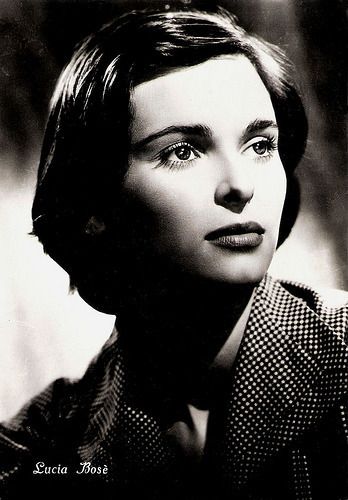
Italian postcard in the series Divi del Cinema by Vetta Traldi, Milano, no. 7.
Lucia Bosé (1931) is an Italian actress, known for her films from the 1950s for directors Giuseppe De Santis and Michelangelo Antonioni.
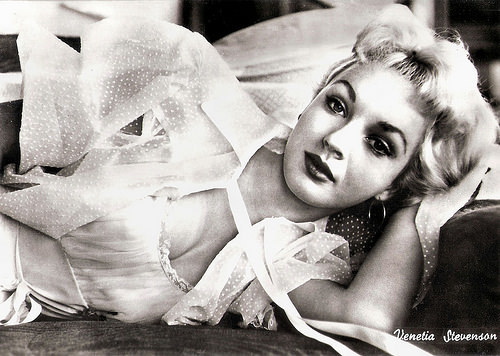
Italian postcard in the series Divi del Cinema, no. 33, by Vetta Traldi, Milano.
Sultry, glamorous blonde Venetia Stevenson (1938) was a British-born Hollywood starlet of the late 1950s.

Anna Maria Ferrero . Italian postcard by Vetta Traldi, Milano in the Divi del Cinema series, no. 51. Sent by mail in 1955.
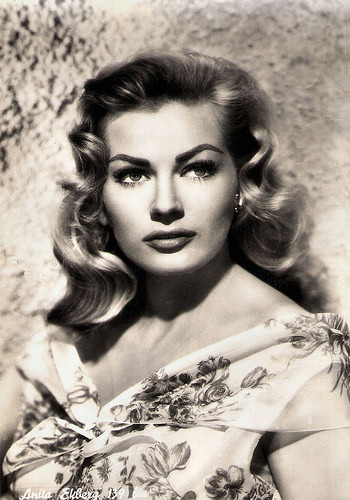
Anita Ekberg . Italian postcard by Vetta Traldi, Milano in the Divi del Cinema series, no. 139 bis.
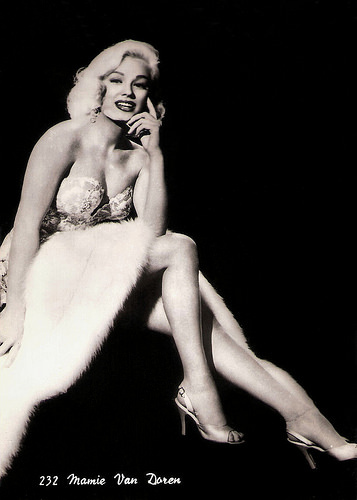
Mamie Van Doren . Italian postcard in the series Divi del Cinema by Vetta Traldi, Milano, no 232.
Sources: The Cabinet Card Gallery and Wikipedia.

Italian postcard by Ed. A. Traldi, Milano, no. 9. Photo: Pittaluga. Publicity still of Elena Sangro as Cinzia and René [Raoul] Mayllard as prince Otis [Ortis] in the Fert production Maciste imperatore/Emperor Maciste (Guido Brignone, 1924).
Maciste imperatore (1924) was part of the popular Maciste series of films starring Bartolomeo Pagano as the strongman Maciste. In the kingdom of Sindagna, the prince regent Stanos tries with all means to dispose of the legitime heir to the throne, prince Ortis. When Maciste and his companion Saetta happen to be in the chaotic empire, they set things straight for the poor, weak prince. Maciste is proclaimed emperor of Sindagna after getting rid of the regent and his puppet ruler, restores peace, and arranges that the prince can also be united with his beloved one. The plot line comes close Mussolini's take over of Italy, 'helping' the weak king Victor Emmanuel III and 'restoring order'.

Italian postcard by Ed. A. Traldi, Milano, no. 323. Photo: Fontana.
Considering her profile, it is not hard to imagine why critics and artists of the early 20th century compared stage and film diva Lyda Borelli (1887-1959) to the heroines of Aubrey Beardsley.

Italian postcard by Ed. A. Traldi, Milano, no. 409. Photo: Pinto, Roma.
Pina Menichelli (1890-1984) was one of the Italian divas of the silent era. After starting her film career at the Roman Cines company in 1913, she was catapulted into stardom by Giovanni Pastrone's Dannunzian film Il Fuoco (1915). Because of her femme fatale, men devouring type and her extreme and sudden gestures she was nicknamed Notre Dame des Spasmes. Menichelli did however know how to play also in restrained ways, as her masterpiece Tigre Reale (Pastrone 1916) showed.

Italian postcard by Ed. A. Traldi, Milano, no. 563.
Polish singer and actress Helena Makowska aka Elena Makowska (1893-1964) was a beautiful diva of the Italian silent cinema in the 1910s. During the 1920s, she moved to Berlin and also became a star of the German cinema.

Italian postcard by Ed. A. Traldi, Milano, no. 738. Photo: publicity still of Rina De Liguoro dying in the final scene of Messalina (Enrico Guazzoni, 1924).
For diva Rina De Liguoro , the epic Messalina (1924) was the start of a prolific career in Italian silent cinema in the 1920s, with films like Quo vadis? (1924) and Gli ultimi giorni di Pompeii (1926). In the late 1920s she also performed in Germany and France, e.g. in Casanova (1927).

Italian postcard by Ed. Traldi, Milano, no. 795. Photo: Pittaluga Films, Torino.
Diomira Jacobini (1899-1959) was one of the stars of the Italian silent cinema. She was the younger sister of diva Maria Jacobini , in whose shadow she always stayed. Diomira appeared in some 55 films in Italy, Germany and Denmark.

Italian postcard by Ed. A. Traldi, Milano. Photo: Westi SAIC. Publicity still for La cavalcata ardente (Carmine Gallone, 1925) with Emilio Ghione as the Prince of Santafé.
The highly successful film La cavalcata ardente (1925) was a melodrama set against the background of the conquest of Naples by Garibaldi's volunteers. Soava Gallone plays an aristocratic forced into marriage with an old prince ( Emilio Ghione ) but secretly in love with a patriot ( Gabriel de Gravone ).

Italian postcard by Ed. A. Traldi, Milano. Photo: Soc. A. Stefano Pittaluga, Torino. Publicity still for Maciste all'inferno/Maciste in Hell (Guido Brignone, 1926), with Franz Sala as the devil Barbariccia.
Franz Sala aka Francesco Sala (1886-1952) was a prolific actor of the Italian silent cinema, mostly playing the evil antagonist.

Italian postcard by Ed. A. Traldi, Milano. Photo: Pittaluga Films, Torino. Publicity still for Maciste all'inferno (Guido Brignone, 1926), starring Bartolomeo Pagano as Maciste. Caption: "The Inhabitants of the Underworld."

Italian postcard by Ed. A. Traldi, Milano, no. 819. Photo: Pittaluga Films, Torino. Publicity still for Maciste nella gabbia dei leoni/Maciste in the Lions' Cage (Guido Brignone, 1926).
Maciste nella gabbia dei leoni is an Italian silent adventure film directed by Guido Brignone for the Cinès-Pittaluga studio. In the script, written by Brignone, Maciste is sent to Africa by a circus showman to capture some lions. Maciste nella gabbia dei leoni was the penultimate film of the silent series, followed by Il gigante delle Dolomiti/The Giant of the Dolomites (Guido Brignone, 1927).

Italian postcard in the series Divi del Cinema by Vetta Traldi, Milano, no. 7.
Lucia Bosé (1931) is an Italian actress, known for her films from the 1950s for directors Giuseppe De Santis and Michelangelo Antonioni.

Italian postcard in the series Divi del Cinema, no. 33, by Vetta Traldi, Milano.
Sultry, glamorous blonde Venetia Stevenson (1938) was a British-born Hollywood starlet of the late 1950s.

Anna Maria Ferrero . Italian postcard by Vetta Traldi, Milano in the Divi del Cinema series, no. 51. Sent by mail in 1955.

Anita Ekberg . Italian postcard by Vetta Traldi, Milano in the Divi del Cinema series, no. 139 bis.

Mamie Van Doren . Italian postcard in the series Divi del Cinema by Vetta Traldi, Milano, no 232.
Sources: The Cabinet Card Gallery and Wikipedia.
Published on May 10, 2018 22:00
May 9, 2018
Marion Michael
German film actress and singer Marion Michael (1940-2007) was a one hit wonder as Liane, the jungle girl. As the female Tarzan, the blonde beauty became an icon of the German cinema. Her postcards were even more popular in Germany than Maria Schell's cards.
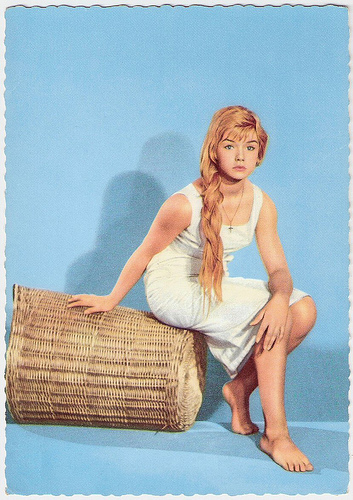
German postcard by UFA (Universum-Film Aktiengesellschaft, Berlin-Tempelhof), no. CK-48. Retail price: 30 Pfg. Photo: Arca-Film.
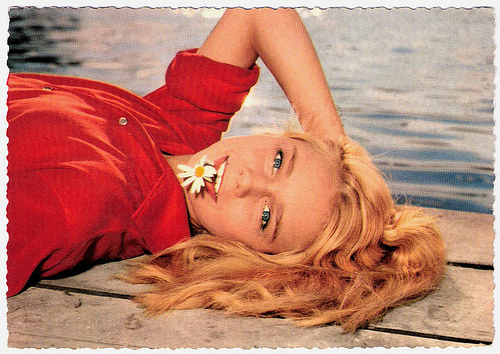
German postcard by Krüger, no. 902/158. Photo: UFA.
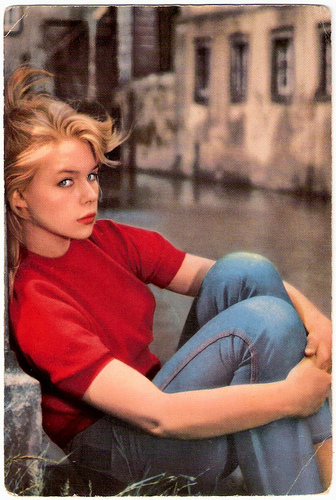
Dutch postcard by Gebr. Spanjersberg, Rotterdam, no. 1009. Photo: UFA.
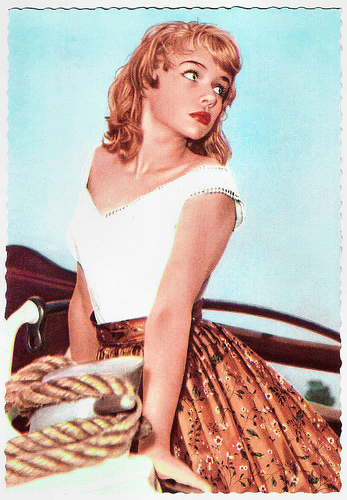
German postcard by Ufa, Berlin-Tempelhof, no. CK-71. Photo: Stempha / Cinepress / Arca Film.
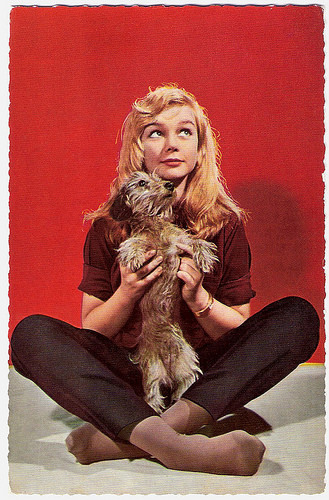
German postcard by Kunst und Bild, Berlin-Charlottenburg, no. C.D. 16.
Topless Goddess
Marion Michael was born as Marion Ilonka Michaela Delonge in Königsberg, Germany (now Kaliningrad, Russia) in 1940. Her father was a doctor.
The last months of the war she spent together with her mother and her four-year older brother on Hiddensee, a small island in the Baltic Sea.
After the war, the family moved to Berlin and Marion attended the secondary school. Already as a ten-year-old, she made her stage debut in a small theatre and was taught classical dance in the ballet school of Tatjana Gsovsky.
When she was only 15, she was selected out of allegedly 12,000 entries for the lead in Liane, das Mädchen aus dem Urwald/Liane, Jungle Goddess (Eduard von Borsody, 1956). This adventure film was largely shot on location in Africa.
The story is about a girl who is discovered in the African jungle by an expedition group which includes Hardy Krüger . A tribe adores her as a goddess. It turns out that she is Liane, the long lost granddaughter of a rich shipowner in Hamburg.
Her dark hair was dyed blonde and she was promoted as the 'German Brigitte Bardot '. Michael appeared topless during the first half of the film and this was part of the success of the film. However, she was acceptable for family audiences as the nature child with no obvious erotic suggestiveness.
The film was a huge box office hit, and producer Gero Wecker offered her a seven-year-contract.The press loved her and photographers paid much money to take her picture exclusively. Her postcards were even more popular in Germany than Maria Schell's postcards. As a 18-years-old, she owned a sports car.
Unfortunately this success of her debut film would not be matched by any of her later films.
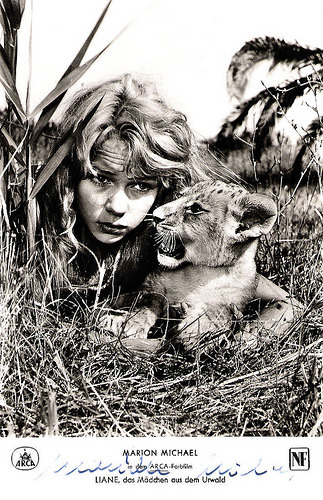
German promotion card. Photo: Arca Film / NF. Publicity still for Liane, das Mädchen aus dem Urwald/Liane, Jungle Goddess (Eduard von Borsody, 1956).
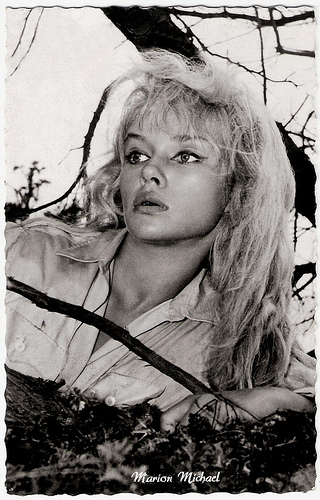
German postcard by Kolibri-Verlag, Minden/Westf, no. 116.
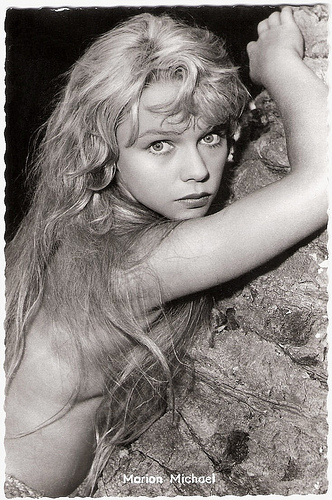
German postcard by Kolibri-Verlag, Minden/Westf., no. 2787.
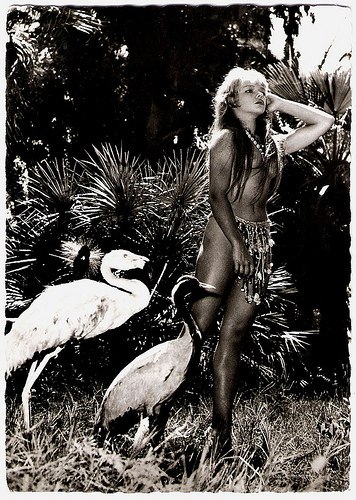
German postcard, no. 542. Photo: Arca.
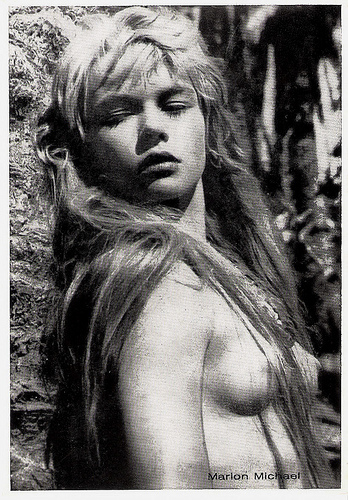
German postcard.
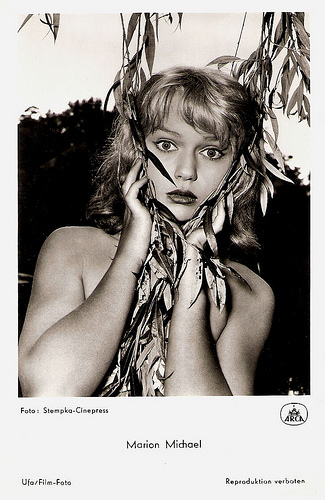
German postcard by Universum-Film Aktiengesellschaft (UFA), Berlin-Tempelhof, no. FK 3865. Retail price: 25 Pfg. Photo: Stempka-Cinepress / Arca.
Car Accident
Marion Michael played next in the comedy Der tolle Bomberg/The Mad Bomberg (Rolf Thiele, 1957) opposite Hans Albers . The film is an adaptation of the 1923 novel of the same title by Josef Winckler which was based on a real historical Westphalian aristocrat of the nineteenth century.
Then followed the sequel Liane, die weiße Sklavin/Jungle Girl and the Slaver (Hermann Leitner, 1957), now opposite Adrian Hoven . Set in North Africa, this story concerns Arab slave traders who abduct Liane and members of her tribe. Later, the two Liane films were edited together and re-marketed as Liane – die Tochter des Dschungels/Liane - The Daughter of the Jungle.
In order to break away from the Liane image, Marion Michael took dance and acting lessons and then played successfully opposite Christian Wolff in melodrama Es war die erste Liebe/First Love (Fritz Stapenhorst, 1958) in which a Catholic theology student falls in love with a country girl.
During the shooting of the crime film Bomben auf Monte Carlo/Bombs on Monte Carlo (Georg Jacoby, 1960) with Eddie Constantine , she had a car accident that left her face temporarily scarred.
She recovered and returned to acting in Schlußakkord/Festival (Wolfgang Liebeneiner, 1960), the Schlagerfilm Davon träumen alle Mädchen/That's What All The Girls Dream About (Thomas Engel, 1961), and Jack und Jenny/Jack and Jenny (Victor Vicas, 1963) with Senta Berger and Ivan Desny .

French postcard. Michael on promotion tour in Paris.
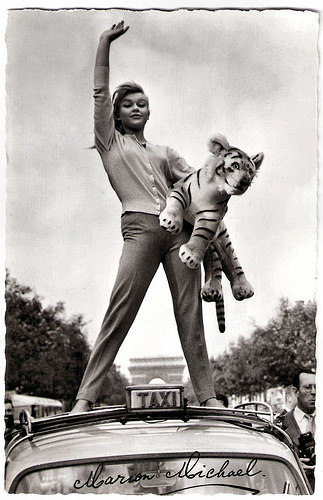
German autograph card.
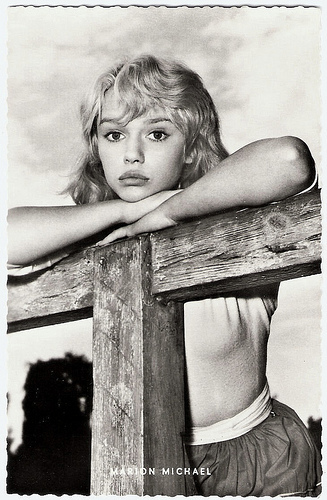
German postcard by Kunst und Bild, Berlin, no. V 122. Photo: Dieter-Eberhard Schmidt, Berlin.
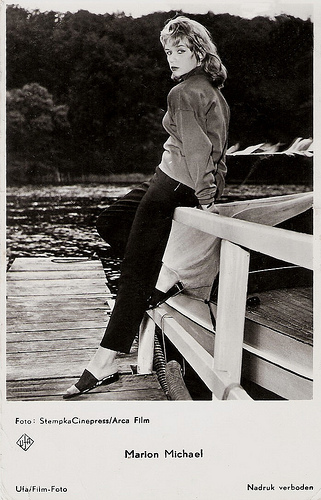
Dutch postcard by Gebr. Spanjersberg N.V., Rotterdam, no. 3536/159. Sent by mail in 1959. Photo: Stempka Cinepress / Arca Film / UFA (Universum-Film Aktiengesellschaft, Berlin-Tempelhof).
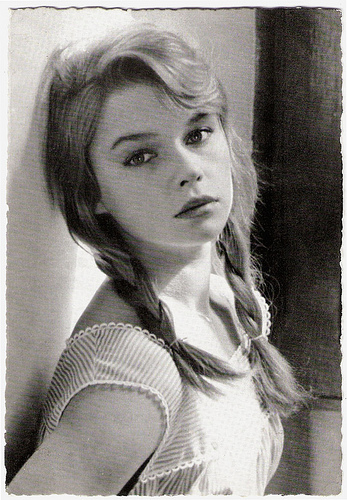
German postcard by WS-Druck, Wanne-Eickel, no. 285. Offered by Honig, Gent, Belgium. Photo: Archiv Filmpress Zürich.
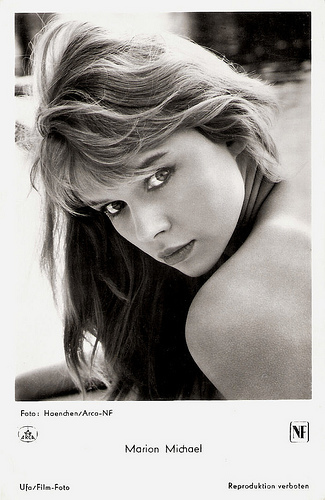
German postcard by Universum-Film Aktiengesellschaft (UFA), no. FK 3762. Retail price: 25 Pfg. Photo: Haenchen / Arca-NF.
Unusual step
The following decade, Marion Michael mainly worked for theatre and TV. For six years she worked at the Städtischen Bühnen Köln. In 1970, she got a son, Benjamin, from an American director, lived in a commune and did some street theatre.
Michael suffered a severe depression after a short marriage to actor Marcel Werner ended, and retired from acting in 1976. For a while she worked as a saleswoman.
In 1979 she took the unusual step of moving from West to East Germany, where she worked as a synchronisation assistant for TV.
Only occasionally she acted in TV-films such as In Hassliebe Lola/In Hate love Lola (Lothar Lambert, 1995) and Blond bis aufs Blut/Blonde Till Blood (Lothar Lambert, 1997).
In 1996 her life became the topic of a TV musical, Liane (Horst Königstein, 1996). She played a small role in the production. The film was nominated for the Adolf Grimme award and the Prix Europa 1997.
In her later years, she remained a well known German film icon. With her second husband, Freimut Patzner, she lived in an old house in Oderbruch.
In 2007 Marion Michael died of heart failure in a hospital in Gartz an der Oder. It was four days before her 67th birthday.

Dutch postcard by Gebr. Spanjersberg N.V., Rotterdam (licency holders for UFA postcards in the Netherlands), no. 4267. Photo: ARCA / Cinepress. Publcity still for Es war die erste Liebe/First Love (Fritz Stapenhorst, 1958) with Christian Wolff .

Dutch postcard. no. 85. Photo: publicity still for Es war die erste Liebe/It was first love (Fritz Stapenhorst, Veit Harlan, 1958).
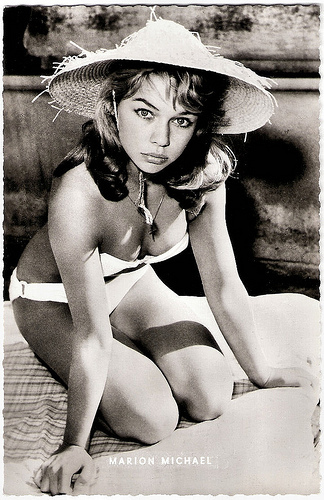
German postcard by Kunst und Bild, Berlin-Charlottenburg, no. V 111. Photo: Krippendorff, Berlin.
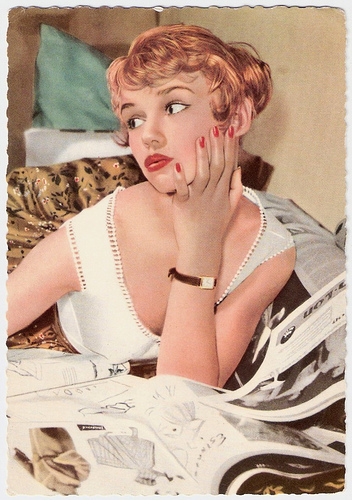
German postcard by UFA, Berlin, no. CK 72. Retail price: 30 Pfg. Photo: Stempka / Arca Film.
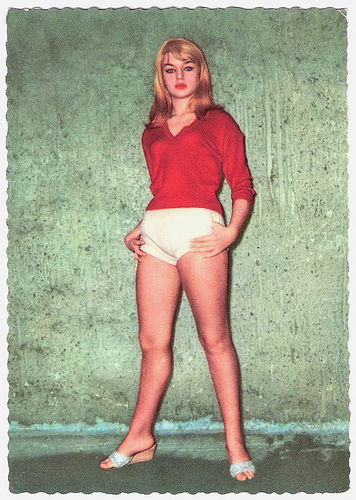
German postcard by UFA (Universum-Film Aktiengesellschaft, Berlin-Tempelhof), no. CK-40. Retail price: 30 Pfg. Photo: Eberhardt Schmidt / UFA / Arca-Film.
Jungle Dance from Liane, das Mädchen aus dem Urwald/Liane, Jungle Goddess (1956). Source: MollyWhippie (YouTube).
Sources: Christian Koehl (Variety), Filmportal.de (German), Stephanie D'Heil (Steffi-line.de - German), Wikipedia and .

German postcard by UFA (Universum-Film Aktiengesellschaft, Berlin-Tempelhof), no. CK-48. Retail price: 30 Pfg. Photo: Arca-Film.

German postcard by Krüger, no. 902/158. Photo: UFA.

Dutch postcard by Gebr. Spanjersberg, Rotterdam, no. 1009. Photo: UFA.

German postcard by Ufa, Berlin-Tempelhof, no. CK-71. Photo: Stempha / Cinepress / Arca Film.

German postcard by Kunst und Bild, Berlin-Charlottenburg, no. C.D. 16.
Topless Goddess
Marion Michael was born as Marion Ilonka Michaela Delonge in Königsberg, Germany (now Kaliningrad, Russia) in 1940. Her father was a doctor.
The last months of the war she spent together with her mother and her four-year older brother on Hiddensee, a small island in the Baltic Sea.
After the war, the family moved to Berlin and Marion attended the secondary school. Already as a ten-year-old, she made her stage debut in a small theatre and was taught classical dance in the ballet school of Tatjana Gsovsky.
When she was only 15, she was selected out of allegedly 12,000 entries for the lead in Liane, das Mädchen aus dem Urwald/Liane, Jungle Goddess (Eduard von Borsody, 1956). This adventure film was largely shot on location in Africa.
The story is about a girl who is discovered in the African jungle by an expedition group which includes Hardy Krüger . A tribe adores her as a goddess. It turns out that she is Liane, the long lost granddaughter of a rich shipowner in Hamburg.
Her dark hair was dyed blonde and she was promoted as the 'German Brigitte Bardot '. Michael appeared topless during the first half of the film and this was part of the success of the film. However, she was acceptable for family audiences as the nature child with no obvious erotic suggestiveness.
The film was a huge box office hit, and producer Gero Wecker offered her a seven-year-contract.The press loved her and photographers paid much money to take her picture exclusively. Her postcards were even more popular in Germany than Maria Schell's postcards. As a 18-years-old, she owned a sports car.
Unfortunately this success of her debut film would not be matched by any of her later films.

German promotion card. Photo: Arca Film / NF. Publicity still for Liane, das Mädchen aus dem Urwald/Liane, Jungle Goddess (Eduard von Borsody, 1956).

German postcard by Kolibri-Verlag, Minden/Westf, no. 116.

German postcard by Kolibri-Verlag, Minden/Westf., no. 2787.

German postcard, no. 542. Photo: Arca.

German postcard.

German postcard by Universum-Film Aktiengesellschaft (UFA), Berlin-Tempelhof, no. FK 3865. Retail price: 25 Pfg. Photo: Stempka-Cinepress / Arca.
Car Accident
Marion Michael played next in the comedy Der tolle Bomberg/The Mad Bomberg (Rolf Thiele, 1957) opposite Hans Albers . The film is an adaptation of the 1923 novel of the same title by Josef Winckler which was based on a real historical Westphalian aristocrat of the nineteenth century.
Then followed the sequel Liane, die weiße Sklavin/Jungle Girl and the Slaver (Hermann Leitner, 1957), now opposite Adrian Hoven . Set in North Africa, this story concerns Arab slave traders who abduct Liane and members of her tribe. Later, the two Liane films were edited together and re-marketed as Liane – die Tochter des Dschungels/Liane - The Daughter of the Jungle.
In order to break away from the Liane image, Marion Michael took dance and acting lessons and then played successfully opposite Christian Wolff in melodrama Es war die erste Liebe/First Love (Fritz Stapenhorst, 1958) in which a Catholic theology student falls in love with a country girl.
During the shooting of the crime film Bomben auf Monte Carlo/Bombs on Monte Carlo (Georg Jacoby, 1960) with Eddie Constantine , she had a car accident that left her face temporarily scarred.
She recovered and returned to acting in Schlußakkord/Festival (Wolfgang Liebeneiner, 1960), the Schlagerfilm Davon träumen alle Mädchen/That's What All The Girls Dream About (Thomas Engel, 1961), and Jack und Jenny/Jack and Jenny (Victor Vicas, 1963) with Senta Berger and Ivan Desny .

French postcard. Michael on promotion tour in Paris.

German autograph card.

German postcard by Kunst und Bild, Berlin, no. V 122. Photo: Dieter-Eberhard Schmidt, Berlin.

Dutch postcard by Gebr. Spanjersberg N.V., Rotterdam, no. 3536/159. Sent by mail in 1959. Photo: Stempka Cinepress / Arca Film / UFA (Universum-Film Aktiengesellschaft, Berlin-Tempelhof).

German postcard by WS-Druck, Wanne-Eickel, no. 285. Offered by Honig, Gent, Belgium. Photo: Archiv Filmpress Zürich.

German postcard by Universum-Film Aktiengesellschaft (UFA), no. FK 3762. Retail price: 25 Pfg. Photo: Haenchen / Arca-NF.
Unusual step
The following decade, Marion Michael mainly worked for theatre and TV. For six years she worked at the Städtischen Bühnen Köln. In 1970, she got a son, Benjamin, from an American director, lived in a commune and did some street theatre.
Michael suffered a severe depression after a short marriage to actor Marcel Werner ended, and retired from acting in 1976. For a while she worked as a saleswoman.
In 1979 she took the unusual step of moving from West to East Germany, where she worked as a synchronisation assistant for TV.
Only occasionally she acted in TV-films such as In Hassliebe Lola/In Hate love Lola (Lothar Lambert, 1995) and Blond bis aufs Blut/Blonde Till Blood (Lothar Lambert, 1997).
In 1996 her life became the topic of a TV musical, Liane (Horst Königstein, 1996). She played a small role in the production. The film was nominated for the Adolf Grimme award and the Prix Europa 1997.
In her later years, she remained a well known German film icon. With her second husband, Freimut Patzner, she lived in an old house in Oderbruch.
In 2007 Marion Michael died of heart failure in a hospital in Gartz an der Oder. It was four days before her 67th birthday.

Dutch postcard by Gebr. Spanjersberg N.V., Rotterdam (licency holders for UFA postcards in the Netherlands), no. 4267. Photo: ARCA / Cinepress. Publcity still for Es war die erste Liebe/First Love (Fritz Stapenhorst, 1958) with Christian Wolff .

Dutch postcard. no. 85. Photo: publicity still for Es war die erste Liebe/It was first love (Fritz Stapenhorst, Veit Harlan, 1958).

German postcard by Kunst und Bild, Berlin-Charlottenburg, no. V 111. Photo: Krippendorff, Berlin.

German postcard by UFA, Berlin, no. CK 72. Retail price: 30 Pfg. Photo: Stempka / Arca Film.

German postcard by UFA (Universum-Film Aktiengesellschaft, Berlin-Tempelhof), no. CK-40. Retail price: 30 Pfg. Photo: Eberhardt Schmidt / UFA / Arca-Film.
Jungle Dance from Liane, das Mädchen aus dem Urwald/Liane, Jungle Goddess (1956). Source: MollyWhippie (YouTube).
Sources: Christian Koehl (Variety), Filmportal.de (German), Stephanie D'Heil (Steffi-line.de - German), Wikipedia and .
Published on May 09, 2018 22:00
May 8, 2018
Shorts by Pathé Frères.
Two years ago, we did this post on postcards for short silent films made before World War I by the French studio Pathé Frères. We loved these very old French cards and recently we found some new ones. They were distributed by Pathé theatres in France, and the films were produced by the studio between 1905 and 1908.
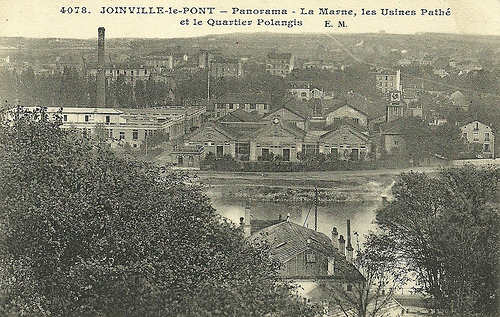
French postcard by F. Testard, Paris, no. 4078. Photo: E.M.
Panorama of the Marne river with the Pathé film factories and the Polangis quarter, at Joinville-le-Pont near Paris. It is here that Pathé produced and developed its celluloid. In contrast to other film companies, Pathé produced its own raw film stock. In its early decades the film studios of Pathé were in Vincennes and Montreuil, but in the early 1920s it would open a studio in Joinville too.
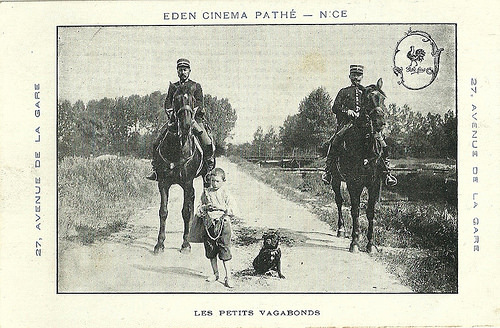
French postcard by Eden Cinema Pathé, Nice. Photo: publicity still for Les petits vagabonds/Young Tramps (Pathé Frères, Lucien Nonguet, 1905).
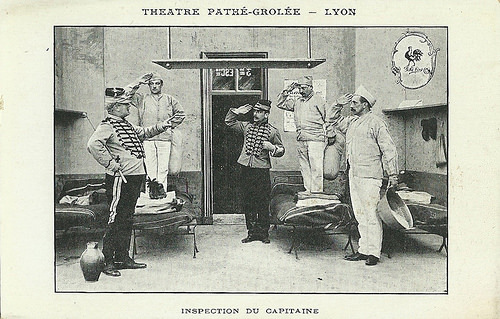
French postcard by Théâtre Pathé Grolée, Lyon. Photo: publicity still for L'inspection du capitaine/Captain's Inspection (Pathé Frères, 1905).
After inspection, the soldiers lie down for a well-earned nap. A drunkard enters the room and disturbs the soldiers who throw him out. He keeps coming back and they finally decide to throw water on him, but the captain gets the shower.
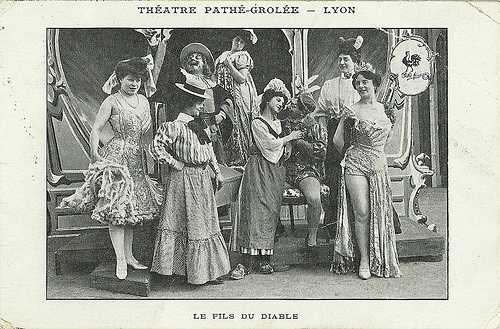
French postcard by Théâtre Pathé Grolée, Lyon. Photo: publicity still for Le fils du diable/The Devil's Son (Pathé Frères, Charles Lucien Lépine, 1906), with André Deed , and cinematography by Segundo De Chomón.
The Devil's son is down in the dumps, so Sganarelle suggests that a trip to Paris would be just the thing to perk him up. Mom and Dad wave bye-bye as he toddles off in his touring car with his native guide.
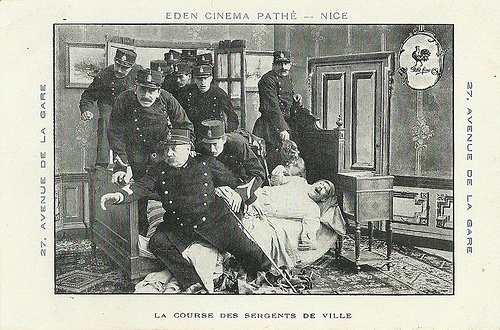
French postcard by Théâtre Pathé Grolée, Lyon. Photo: publicity still for La course des sergents de ville/The Policemen's Race (Pathé Frères, Ferdinand Zecca, 1907), scripted by André Heuzé.
A policeman spots a dog stealing a piece of meat from a butcher's shop, and gives chase. Soon several more policemen have joined the pursuit. But the chase does not turn out as the policemen expect.
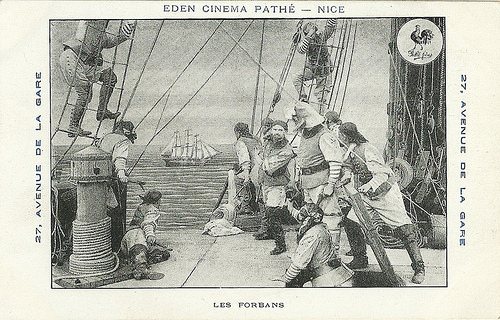
French postcard by Eden Cinema Pathé, Nice. Photo: publicity still for Les Forbans/The Pirates (Pathé Frères, 1907).
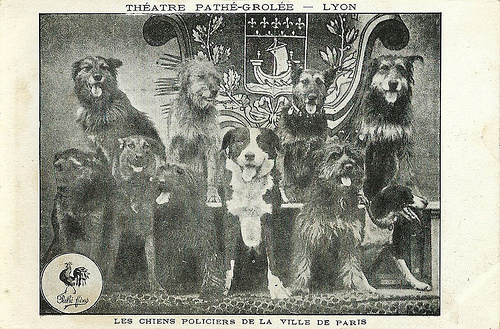
French postcard by Théâtre Pathé Grolée, Lyon. Photo: publicity still for Les chiens policiers de la ville de Paris/The Police Dogs of Paris (Pathé Frères, 1907).
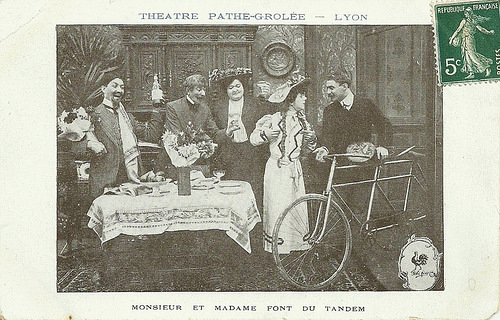
French postcard by Théâtre Pathé Grolée, Lyon. Photo: publicity still for Monsieur et Madame font du tandem/Jollygoods Go Tandeming (Pathé Frères, 1908).
A couple decides, after having dined, to go out on their tandem bicycle. They start well, but in speeding over a bridge they upset two pedestrians, who make a high dive into the water. From this point they enter into a ride of destruction and catastrophe.
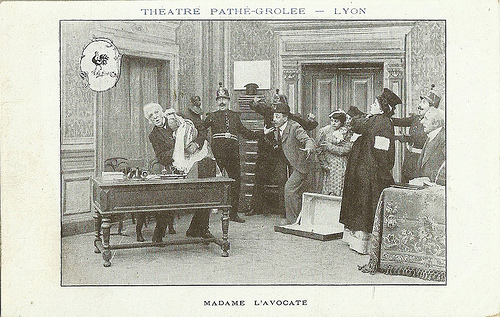
French postcard by Théâtre Pathé Grolée, Lyon. Photo: publicity still for Madame l'avocate/Lady Barrister (Pathé Frères, 1908).
A woman attorney is so taken up with her studies in law that she finds no time to bother with household duties. Her henpecked husband has to take care of the baby, clean the house, do the cooking. When things do not run very smoothly, she decides to take a hand in the domestic affairs herself. It all ends in chaos.
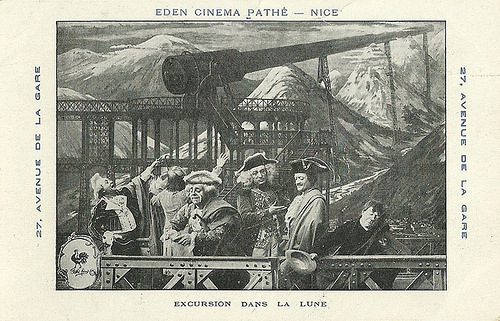
French postcard by Eden Cinema Pathé, Nice. Photo: publicity still for Excursion dans la lune/An Excursion to the Moon (Pathé Frères, Segundo de Chomón, 1908), sets by Vincent Lorant-Heilbronn.
Georges Méliès' best-known film, Le voyage dans la lune/A Trip to the Moon (1902), is inspired by Jules Verne's De la terre à la lune/From the Earth to the Moon and H.G. Wells' First Men on the Moon. In 1908, Segundo de Chomón made Excursion dans la lune/An Excursion to the Moon, an imitation of Méliès' work, which is preserved with the original Pathé Frères stencil color.
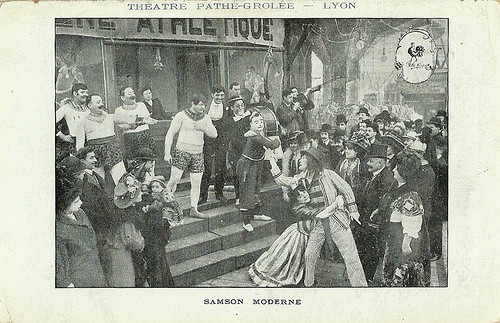
French postcard by Théâtre Pathé Grolée, Lyon. Photo: publicity still for Samson moderne/A Modern Samson (Pathé Frères, 1908).
On the fairground an unknown young man manages to conquer the wrestling champion. When after a series of adventures he is imprisoned he breaks down the walls like a modern Samson. Returned home his wife celebrates him with wine but is jealous of his force, so like a modern Delila she cuts his hair off in his sleep. Awakened, the man has lost his hair and his strength.
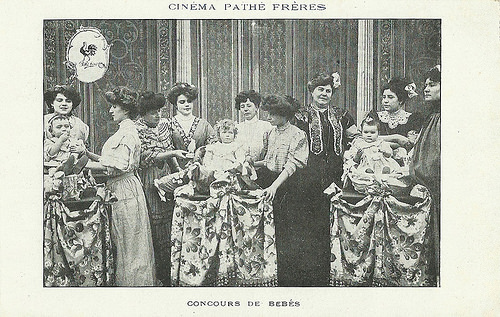
French postcard by Cinema Pathé Frères. Photo: publicity still for Concours de bébés/The Baby Show (Pathé Frères, 1908).
Having much pride in the beauty of her little charge, a fussy governess enters her mistress baby to compete in a baby show. But the baby's elder sister, being whipped by the governess, resolves to even matters, and when the fond nurse-girl lays the infant in the basket and leaves the scene for a moment the little girl takes the baby out and puts a dog in instead.
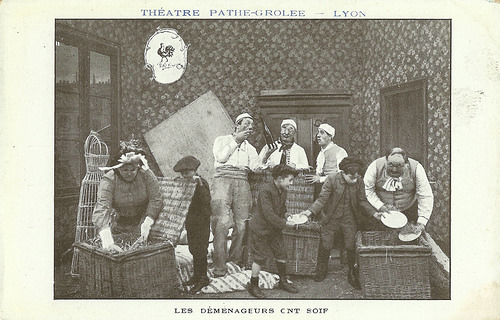
French postcard by Théâtre Pathé Grolée, Lyon. Photo: publicity still for Les démenageurs ont soif/Thirsty Moving Men (Pathé Frères, 1908).
Four thirsty movers empty the wine bottles they discover in a basket, after which chaos and destruction starts. The movers destroy and lose most luggage underway, so the owners can only give the drunken movers a good spanking and go and get new furniture.
Sources: Fondation Jerome Seydoux Pathé (French) and IMDb.

French postcard by F. Testard, Paris, no. 4078. Photo: E.M.
Panorama of the Marne river with the Pathé film factories and the Polangis quarter, at Joinville-le-Pont near Paris. It is here that Pathé produced and developed its celluloid. In contrast to other film companies, Pathé produced its own raw film stock. In its early decades the film studios of Pathé were in Vincennes and Montreuil, but in the early 1920s it would open a studio in Joinville too.

French postcard by Eden Cinema Pathé, Nice. Photo: publicity still for Les petits vagabonds/Young Tramps (Pathé Frères, Lucien Nonguet, 1905).

French postcard by Théâtre Pathé Grolée, Lyon. Photo: publicity still for L'inspection du capitaine/Captain's Inspection (Pathé Frères, 1905).
After inspection, the soldiers lie down for a well-earned nap. A drunkard enters the room and disturbs the soldiers who throw him out. He keeps coming back and they finally decide to throw water on him, but the captain gets the shower.

French postcard by Théâtre Pathé Grolée, Lyon. Photo: publicity still for Le fils du diable/The Devil's Son (Pathé Frères, Charles Lucien Lépine, 1906), with André Deed , and cinematography by Segundo De Chomón.
The Devil's son is down in the dumps, so Sganarelle suggests that a trip to Paris would be just the thing to perk him up. Mom and Dad wave bye-bye as he toddles off in his touring car with his native guide.

French postcard by Théâtre Pathé Grolée, Lyon. Photo: publicity still for La course des sergents de ville/The Policemen's Race (Pathé Frères, Ferdinand Zecca, 1907), scripted by André Heuzé.
A policeman spots a dog stealing a piece of meat from a butcher's shop, and gives chase. Soon several more policemen have joined the pursuit. But the chase does not turn out as the policemen expect.

French postcard by Eden Cinema Pathé, Nice. Photo: publicity still for Les Forbans/The Pirates (Pathé Frères, 1907).

French postcard by Théâtre Pathé Grolée, Lyon. Photo: publicity still for Les chiens policiers de la ville de Paris/The Police Dogs of Paris (Pathé Frères, 1907).

French postcard by Théâtre Pathé Grolée, Lyon. Photo: publicity still for Monsieur et Madame font du tandem/Jollygoods Go Tandeming (Pathé Frères, 1908).
A couple decides, after having dined, to go out on their tandem bicycle. They start well, but in speeding over a bridge they upset two pedestrians, who make a high dive into the water. From this point they enter into a ride of destruction and catastrophe.

French postcard by Théâtre Pathé Grolée, Lyon. Photo: publicity still for Madame l'avocate/Lady Barrister (Pathé Frères, 1908).
A woman attorney is so taken up with her studies in law that she finds no time to bother with household duties. Her henpecked husband has to take care of the baby, clean the house, do the cooking. When things do not run very smoothly, she decides to take a hand in the domestic affairs herself. It all ends in chaos.

French postcard by Eden Cinema Pathé, Nice. Photo: publicity still for Excursion dans la lune/An Excursion to the Moon (Pathé Frères, Segundo de Chomón, 1908), sets by Vincent Lorant-Heilbronn.
Georges Méliès' best-known film, Le voyage dans la lune/A Trip to the Moon (1902), is inspired by Jules Verne's De la terre à la lune/From the Earth to the Moon and H.G. Wells' First Men on the Moon. In 1908, Segundo de Chomón made Excursion dans la lune/An Excursion to the Moon, an imitation of Méliès' work, which is preserved with the original Pathé Frères stencil color.

French postcard by Théâtre Pathé Grolée, Lyon. Photo: publicity still for Samson moderne/A Modern Samson (Pathé Frères, 1908).
On the fairground an unknown young man manages to conquer the wrestling champion. When after a series of adventures he is imprisoned he breaks down the walls like a modern Samson. Returned home his wife celebrates him with wine but is jealous of his force, so like a modern Delila she cuts his hair off in his sleep. Awakened, the man has lost his hair and his strength.

French postcard by Cinema Pathé Frères. Photo: publicity still for Concours de bébés/The Baby Show (Pathé Frères, 1908).
Having much pride in the beauty of her little charge, a fussy governess enters her mistress baby to compete in a baby show. But the baby's elder sister, being whipped by the governess, resolves to even matters, and when the fond nurse-girl lays the infant in the basket and leaves the scene for a moment the little girl takes the baby out and puts a dog in instead.

French postcard by Théâtre Pathé Grolée, Lyon. Photo: publicity still for Les démenageurs ont soif/Thirsty Moving Men (Pathé Frères, 1908).
Four thirsty movers empty the wine bottles they discover in a basket, after which chaos and destruction starts. The movers destroy and lose most luggage underway, so the owners can only give the drunken movers a good spanking and go and get new furniture.
Sources: Fondation Jerome Seydoux Pathé (French) and IMDb.
Published on May 08, 2018 22:00
May 7, 2018
Sally Gray
Glamorous English film actress Sally Gray (1915-2006) appeared in many musical comedies of the 1930s and 1940s. The hazel-eyed blonde Gray was seen as ‘a British rival to Ginger Rogers.’ After a break from performing, she emerged in the mid-1940s as a sultry beauty who starred in a series of moody dramas and suspenseful thrillers. Later she became Constance Vera Browne, Baroness Oranmore and Browne.
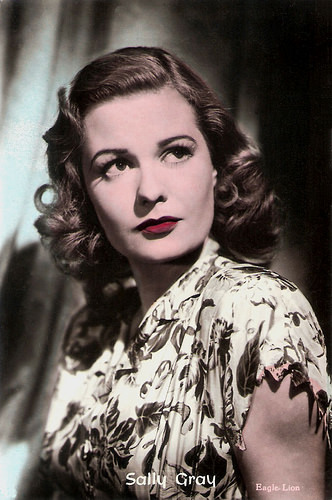
British autograph card. Photo: Eagle Lion.
Private dance lessons by Fred Astaire
Sally Gray was born Constance Vera Stevens in Holloway, London, in 1915. Gray was the daughter of Charles Stevens, who drove a motor cab, and his wife, Gertrude Grace. Her mother was a ballet dancer and her grandmother a "principal boy" in the 1870s. Her father died when Gray was young.
As a child, she trained at Fay Compton's School of Dramatic Art, and began acting on stage at the age of 10. Gray made her professional stage debut at the age of twelve in All God's Chillun at the Globe Theatre in London, playing an African boy. When she was 14, Gray appeared in a minstrel show at the Gate Theatre in London.
She made her film debut under the name of Constance Stevens with a bit part in the comedy School for Scandal (Thorold Dickinson, Maurice Elvey, 1930) starring Basil Gill and Madeleine Carroll . The now as lost considered film is the only feature-length film shot using the unsuccessful Raycol colour process.
Sally then went back to school for two years, training again at Fay Compton’s School of Dramatic Art, during which time she performed in cabarets. She appeared in The Gay Divorce (1933) on stage with Fred Astaire. Astaire gave her private dance lessons.
The agent John Gliddon, who had discovered Vivien Leigh , saw the 18 years-old Gray in the musical Jill Darling (1934) and signed her. Gray returned to films in 1935, with a small part in the historical drama The Dictator (Victor Saville, 1935), starring Clive Brook . She could also be seen in the comedy Cross Currents (Adrian Brunel, 1935), the musical Radio Pirates (Ivar Campbell, 1935), the comedy Lucky Days (Reginald Denham, 1935) with Chili Bouchier, and the crime film Checkmate (George Pearson, 1935).
She returned on stage and was spotted by multi-talented actor-producer Stanley Lupino, who fell in love with her. Lupino was part of a theatrical dynasty that went back to 1634, and he was the father of the actress Ida Lupino. Gray had the female lead in his comedy Cheer Up (Leo Mittler, 1936) starring Stanley Lupino.
She also had leads in the musical drama Calling the Tune (Reginald Denham, Thorold Dickinson, 1936), the thriller Cafe Colette (Paul L. Stein, 1937) with Paul Cavanagh, and the musical Saturday Night Revue (Norman Lee, 1937) with Billy Milton. In 1936 she was earning an impressive £150 a week.
Gray had support roles in the thriller Lightning Conductor (Maurice Elvey, 1937), the musical Over She Goes (Graham Cutts, 1937) with Lupino, The Edgar Wallace thriller Mr. Reeder in Room 13 (Norman Lee, 1937), and the musical Hold My Hand (Thornton Freeland, 1938) with Lupino. Gray was the female lead in the drama Sword of Honour (Maurice Elvey, 1938), the RKO production The Saint in London (John Paddy Carstairs, 1939) with George Sanders as Simon Templar, the musical comedy The Lambeth Walk (Albert de Courville, 1939) with Lupino Lane, Stanley Lupino’s nephew.
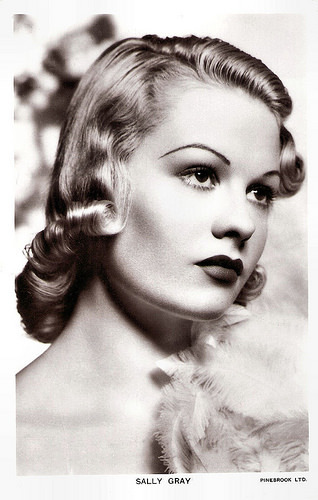
British postcard in the Picturegoer series, London, no. 1261. Photo: Pinebrook LTD.
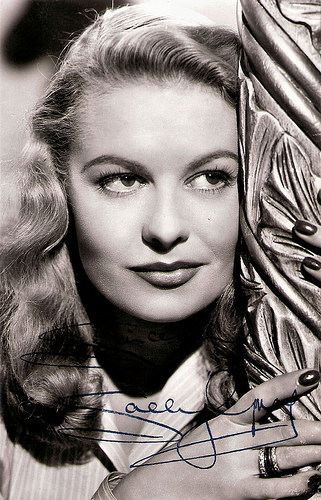
British autograph card.
The death of her lover, mentor and friend
During the war years, Sally Gray continued her career smoothly. She played a non-musical role in the thriller A Window in London (Herbert Mason, 1940), starring Michael Redgrave . According to Tom Vallance in The Independent , “she was convincing in her offbeat role as an illusionist's wife in a neatly constructed thriller”.
Then she played Miss America in the comedy Olympic Honeymoon (Alfred J. Goulding, 1940) with Claude Hulbert , and had the female lead in another British RKO production, The Saint's Vacation (Leslie Fenton, 1941), this time with Hugh Sinclair as Simon Templar.
She had a sensitive role in the romantic melodrama Dangerous Moonlight (Brian Desmond Hurst, 1941). Tom Vallance: “Particularly remembered for its theme music, Richard Addinsell's "The Warsaw Concerto", the story of a Polish pianist ( Anton Walbrook ) who joins an air squadron against the wishes of his girlfriend (Gray), loses his memory after being wounded in the Battle of Britain, but regains it (and is reunited with his sweetheart) when he starts playing the concerto, had great appeal for wartime audiences.”
The same year she appeared in Lady Behave, London's first major musical since the Second World War began. Stanley Lupino, who had cancer, had written the musical and co-starred. The show had to close after a month because of Lupino's illness. Gray returned to the stage to star in My Sister Eileen (1942) with Coral Browne.
Lupino died, leaving Gray £10,000. Gray had a nervous breakdown, resulting in her retirement for a number of years. Lupino had been not only her lover, but her mentor and friend.
She returned to the screen in 1946 and made her strongest bid for stardom in a series of melodramas. Tom Vallance again in The Independent : “Her husky voice was particularly attractive, and distinctively different from other stars of the time.”
She appeared in the hospital thriller Green for Danger (Sidney Gilliat, 1946) with Alastair Sim and Trevor Howard , the drama Carnival (Stanley Haynes 1946) with Michael Wilding and Stanley Holloway, the stylish, brutal Film Noir They Made Me a Fugitive (Alberto Cavalcanti, 1947) with Trevor Howard , and the drama The Mark of Cain (Brian Desmond Hurst, 1947), starring Eric Portman.
Gray then made the thriller Silent Dust (Lance Comfort, 1948) and the Film Noir Obsession (Edward Dmytryk 1949). Ronald Bergan in The Guardian : “Arguably Gray's best and meatiest role came in the McCarthyist exile Edward Dmytryk's Obsession (1949), as the cheating wife of psychiatrist Robert Newton, who plans a slow death for her latest lover.”
Her final film was the spy thriller Escape Route (Seymour Friedman, Peter Graham Scott, 1952) with ageing American tough guy George Raft as an FBI agent in England. RKO executives, impressed with Gray, authorised producer William Sistrom to offer her a long-term contract if she would move to the United States. However, she declined the offer and instead retired in 1952 after getting married.
In 1951, Gray had married The 4th Baron Oranmore and Browne, an Anglo-Irish peer. They lived in a castle in County Mayo, Ireland. The couple kept the marriage secret until the 1953 coronation, at which she appeared with her husband. The final phase of Gray's life found her very much in the upper class, and she led a comfortable life, preferring not to talk about her acting career.
In the early 1960s the couple returned to England and settled in a flat in Eaton Place, Belgravia, London. Gray tended assiduously to her gardening in later years. After 51 years of marriage, her husband died in 2002 at the age of 100. The couple had no children. Sally Gray died in 2006 in London, England. She was 91.
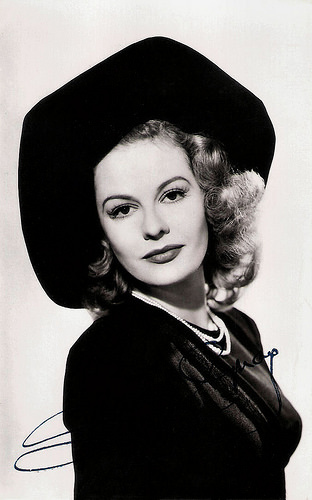
British autograph card.
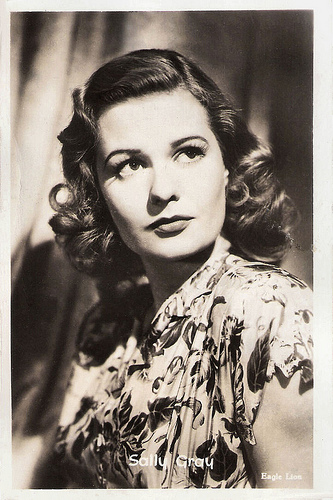
Dutch postcard. Photo: Eagle Lion.
Sources: Tom Vallance (The Independent), Ronald Bergan (The Guardian), (IMDb), Wikipedia and .

British autograph card. Photo: Eagle Lion.
Private dance lessons by Fred Astaire
Sally Gray was born Constance Vera Stevens in Holloway, London, in 1915. Gray was the daughter of Charles Stevens, who drove a motor cab, and his wife, Gertrude Grace. Her mother was a ballet dancer and her grandmother a "principal boy" in the 1870s. Her father died when Gray was young.
As a child, she trained at Fay Compton's School of Dramatic Art, and began acting on stage at the age of 10. Gray made her professional stage debut at the age of twelve in All God's Chillun at the Globe Theatre in London, playing an African boy. When she was 14, Gray appeared in a minstrel show at the Gate Theatre in London.
She made her film debut under the name of Constance Stevens with a bit part in the comedy School for Scandal (Thorold Dickinson, Maurice Elvey, 1930) starring Basil Gill and Madeleine Carroll . The now as lost considered film is the only feature-length film shot using the unsuccessful Raycol colour process.
Sally then went back to school for two years, training again at Fay Compton’s School of Dramatic Art, during which time she performed in cabarets. She appeared in The Gay Divorce (1933) on stage with Fred Astaire. Astaire gave her private dance lessons.
The agent John Gliddon, who had discovered Vivien Leigh , saw the 18 years-old Gray in the musical Jill Darling (1934) and signed her. Gray returned to films in 1935, with a small part in the historical drama The Dictator (Victor Saville, 1935), starring Clive Brook . She could also be seen in the comedy Cross Currents (Adrian Brunel, 1935), the musical Radio Pirates (Ivar Campbell, 1935), the comedy Lucky Days (Reginald Denham, 1935) with Chili Bouchier, and the crime film Checkmate (George Pearson, 1935).
She returned on stage and was spotted by multi-talented actor-producer Stanley Lupino, who fell in love with her. Lupino was part of a theatrical dynasty that went back to 1634, and he was the father of the actress Ida Lupino. Gray had the female lead in his comedy Cheer Up (Leo Mittler, 1936) starring Stanley Lupino.
She also had leads in the musical drama Calling the Tune (Reginald Denham, Thorold Dickinson, 1936), the thriller Cafe Colette (Paul L. Stein, 1937) with Paul Cavanagh, and the musical Saturday Night Revue (Norman Lee, 1937) with Billy Milton. In 1936 she was earning an impressive £150 a week.
Gray had support roles in the thriller Lightning Conductor (Maurice Elvey, 1937), the musical Over She Goes (Graham Cutts, 1937) with Lupino, The Edgar Wallace thriller Mr. Reeder in Room 13 (Norman Lee, 1937), and the musical Hold My Hand (Thornton Freeland, 1938) with Lupino. Gray was the female lead in the drama Sword of Honour (Maurice Elvey, 1938), the RKO production The Saint in London (John Paddy Carstairs, 1939) with George Sanders as Simon Templar, the musical comedy The Lambeth Walk (Albert de Courville, 1939) with Lupino Lane, Stanley Lupino’s nephew.

British postcard in the Picturegoer series, London, no. 1261. Photo: Pinebrook LTD.

British autograph card.
The death of her lover, mentor and friend
During the war years, Sally Gray continued her career smoothly. She played a non-musical role in the thriller A Window in London (Herbert Mason, 1940), starring Michael Redgrave . According to Tom Vallance in The Independent , “she was convincing in her offbeat role as an illusionist's wife in a neatly constructed thriller”.
Then she played Miss America in the comedy Olympic Honeymoon (Alfred J. Goulding, 1940) with Claude Hulbert , and had the female lead in another British RKO production, The Saint's Vacation (Leslie Fenton, 1941), this time with Hugh Sinclair as Simon Templar.
She had a sensitive role in the romantic melodrama Dangerous Moonlight (Brian Desmond Hurst, 1941). Tom Vallance: “Particularly remembered for its theme music, Richard Addinsell's "The Warsaw Concerto", the story of a Polish pianist ( Anton Walbrook ) who joins an air squadron against the wishes of his girlfriend (Gray), loses his memory after being wounded in the Battle of Britain, but regains it (and is reunited with his sweetheart) when he starts playing the concerto, had great appeal for wartime audiences.”
The same year she appeared in Lady Behave, London's first major musical since the Second World War began. Stanley Lupino, who had cancer, had written the musical and co-starred. The show had to close after a month because of Lupino's illness. Gray returned to the stage to star in My Sister Eileen (1942) with Coral Browne.
Lupino died, leaving Gray £10,000. Gray had a nervous breakdown, resulting in her retirement for a number of years. Lupino had been not only her lover, but her mentor and friend.
She returned to the screen in 1946 and made her strongest bid for stardom in a series of melodramas. Tom Vallance again in The Independent : “Her husky voice was particularly attractive, and distinctively different from other stars of the time.”
She appeared in the hospital thriller Green for Danger (Sidney Gilliat, 1946) with Alastair Sim and Trevor Howard , the drama Carnival (Stanley Haynes 1946) with Michael Wilding and Stanley Holloway, the stylish, brutal Film Noir They Made Me a Fugitive (Alberto Cavalcanti, 1947) with Trevor Howard , and the drama The Mark of Cain (Brian Desmond Hurst, 1947), starring Eric Portman.
Gray then made the thriller Silent Dust (Lance Comfort, 1948) and the Film Noir Obsession (Edward Dmytryk 1949). Ronald Bergan in The Guardian : “Arguably Gray's best and meatiest role came in the McCarthyist exile Edward Dmytryk's Obsession (1949), as the cheating wife of psychiatrist Robert Newton, who plans a slow death for her latest lover.”
Her final film was the spy thriller Escape Route (Seymour Friedman, Peter Graham Scott, 1952) with ageing American tough guy George Raft as an FBI agent in England. RKO executives, impressed with Gray, authorised producer William Sistrom to offer her a long-term contract if she would move to the United States. However, she declined the offer and instead retired in 1952 after getting married.
In 1951, Gray had married The 4th Baron Oranmore and Browne, an Anglo-Irish peer. They lived in a castle in County Mayo, Ireland. The couple kept the marriage secret until the 1953 coronation, at which she appeared with her husband. The final phase of Gray's life found her very much in the upper class, and she led a comfortable life, preferring not to talk about her acting career.
In the early 1960s the couple returned to England and settled in a flat in Eaton Place, Belgravia, London. Gray tended assiduously to her gardening in later years. After 51 years of marriage, her husband died in 2002 at the age of 100. The couple had no children. Sally Gray died in 2006 in London, England. She was 91.

British autograph card.

Dutch postcard. Photo: Eagle Lion.
Sources: Tom Vallance (The Independent), Ronald Bergan (The Guardian), (IMDb), Wikipedia and .
Published on May 07, 2018 22:00
May 6, 2018
Gabrielle Réjane
Gabrielle Réjane (1856-1920) was a successful French stage actress and early silent film actress. She is most famous for her role of Catherine, in Sardou's play Madame Sans-Gene (1893), which she filmed twice.
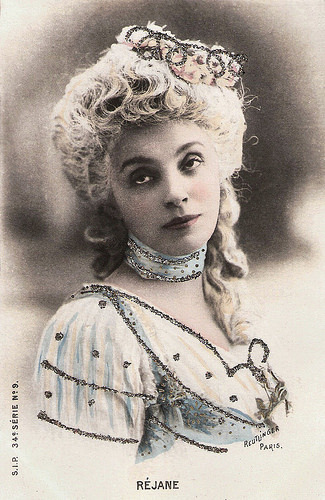
French postcard by S.I.P., 34e serie, no. 9. Photo: Reutlinger, Paris.
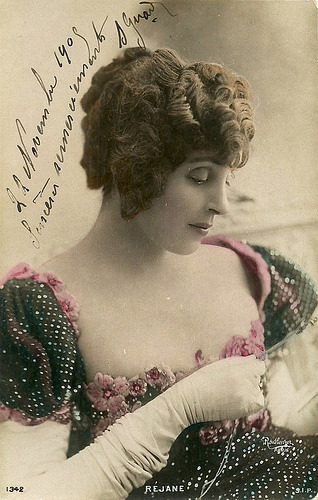
French postcard, no. 1342. Photo Reutlinger, Paris. Mailed in 1905.
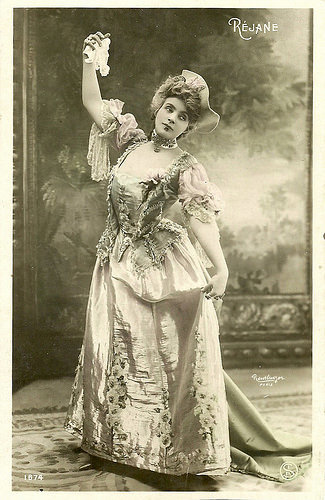
French postcard by S.I.P., no. 1874. Photo: Reutlinger, Paris. Mailed in 1911.
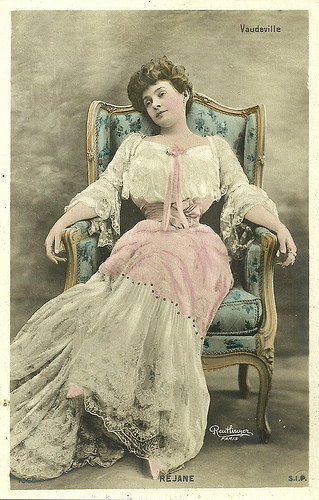
French postcard by S.I.P.. Photo Reutlinger, Paris. Caption: Vaudeville.
An emotional actress of rare gifts
Gabrielle Réjane was born as Gabrielle-Charlotte Reju in 1856 in Paris. She was the daughter of an actor.
She became a pupil of Régnier at the Conservatoire, and took the second prize for comedy in 1874. Her debut was the next year, during which she played a number of light — especially soubrette — parts.
Her first great success was in Henri Meilhac's Ma camarade (1883), in which she expressed her emotional sympathy to gain great audience appeal. She soon became known as an emotional actress of rare gifts, notably in Décor, Germinie Lacerteux, Ma cousine, Amoureuse and Lysistrata.
In 1892 a pregnant Réjane married Paul Porel, the director of the Théâtre du Vaudeville, but the marriage dissolved in 1905. Their only child was a daughter Germaine.
In 1893 she appeared in Paris, and soon thereafter in London and New York, in her most famous role as Catherine in Victorien Sardou's Madame Sans-Gêne. Her performances in the play made her as well known in England and the United States as in Paris, and in later years she appeared in characteristic parts in both countries, being particularly successful in Zaza and La Passerelle.
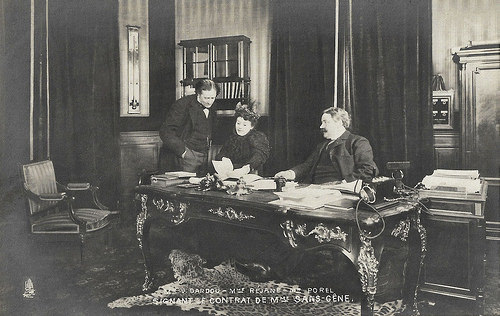
French postcard by Raphael Tuck & Fils, Editeurs, Paris, Série 200. Photo: publicity still for the stage play Madame Sans-Gêne. Caption: Victorien Sardou, madame Réjane and Léon Porel signing the contract for Madame Sans-Gêne.
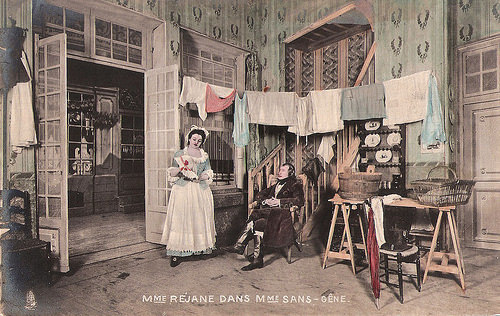
French postcard by Raphael Tuck & Fils, Editeurs, Paris, Série 200. Photo: publicity still for the stage play Madame Sans-Gêne.
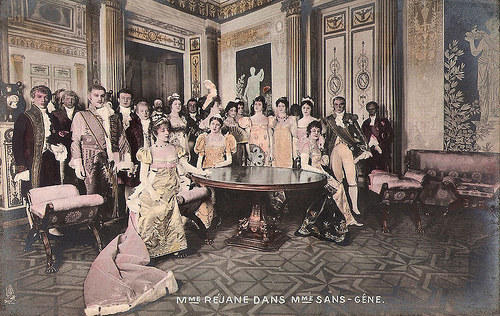
French postcard by Raphael Tuck & Fils, Editeurs, Paris, Série 200. Photo: publicity still for the stage play Madame Sans-Gêne.
French vivacity and animated expression
In 1906, Gabrielle Réjane opened the Théâtre Réjane, where she continued to act as well as manage the theatre.
Along with Sarah Bernhardt , she served as the model for the character of the actress Berma in Marcel Proust's novel In Search of Lost Time (A la Recherche du Temps Perdu).
The French vivacity and animated expression that was Réjane's trademark made her unrivalled in the parts which she had made her own.
She appeared in several short films during the early years of cinema, including an experimental 1908 sound film for Gaumont. She made two short and silent film adaptations of her greatest success, Madame Sans-Gêne (Clément Maurice, 1900) and Madame Sans-Gêne (André Calmettes, Henri Desfontaines 1911).
Her other films included Britannicus (André Calmettes, 1908) with Jean Mounet-Sully , the propaganda film Alsace (Henri Pouctal, 1916), and Miarka, la fille à l'ourse/Gypsy Passion (Louis Mercanton, 1920) starring Desdemona Mazza and Ivor Novello .
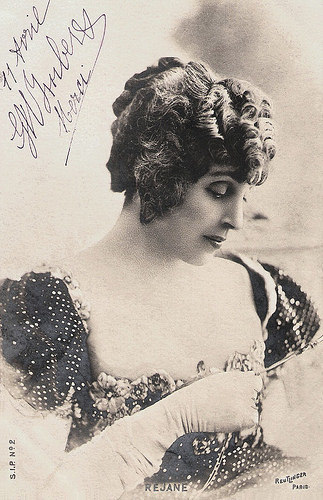
French postcard by S.I.P., no. 2. Photo: Reutlinger, Paris.
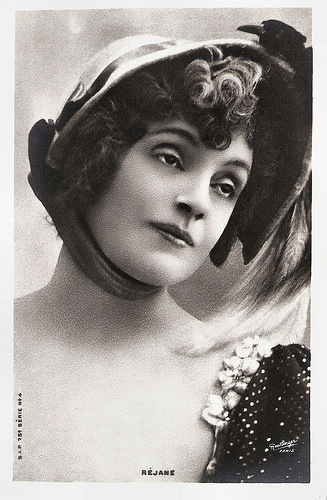
French postcard by S.I.P., 75th Series, no. 4. Photo: Reutlinger, Paris.
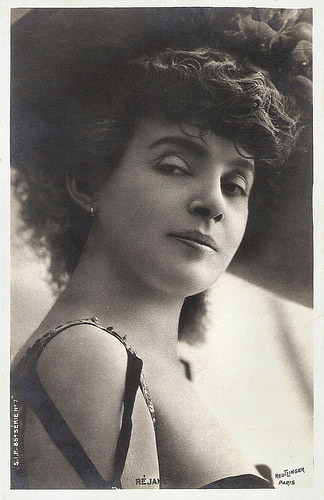
French postcard by S.I.P., 85th Series, no. 7. Photo: Reutlinger, Paris.
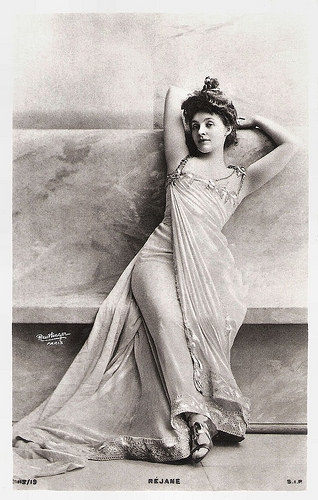
French postcard by S.I.P., no. 118/19. Photo: Reutlinger, Paris.
The Marseillaise on the tomb of her son
In Alsace (Henri Pouctal, 1916), a film that luckily still survives, Gabrielle Réjane reprised the role Gaston Leroux had written for her as stage play, with which she had been very successful in early 1913 at her own theatre.
Two families, one, French, one German, rival each other in the contested province of the Alsace. The French son ( Albert Dieudonné ) falls in love with the daughter of the Germans, Marguerite (Francesca Flory), but his mother (Réjane) tries to prevent the marriage plans.
When he falls ill, she gives in. When war breaks out, he must choose between his German fiancee and his French mother. Both women are fanatics and plotters, the man instead is weak. He is beaten up by a German mob and dies in his mother's arms.
When the film premiered at the Paris Gaumont-Palace, it was a massive success, especially for the final image of Réjane posing as the Marseillaise on the tomb of her son.
The full film, a tinted version found and restored by the Dutch EYE Filmmuseum, and containing English intertitles, can be watched on European Film Gateway
Gabrielle Réjane was made a Knight of the Legion of Honour three months before her death. She died in Paris in 1920 and was buried there in the Cimetière de Passy.
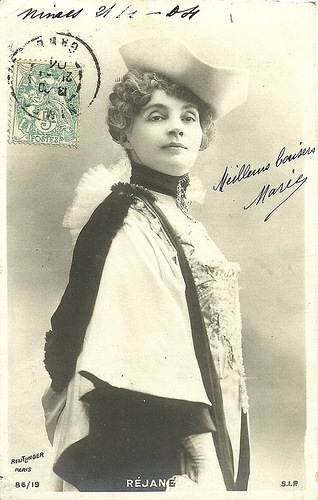
French postcard. Photo Reutlinger, Paris, No. 86/19. S.I.P. Mailed in 1904.
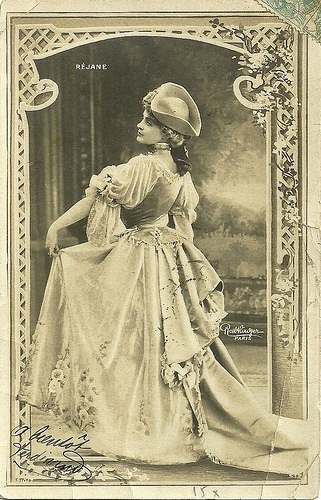
French postcard by S.I.P. Photo Reutlinger, Paris. Mailed in 1906.
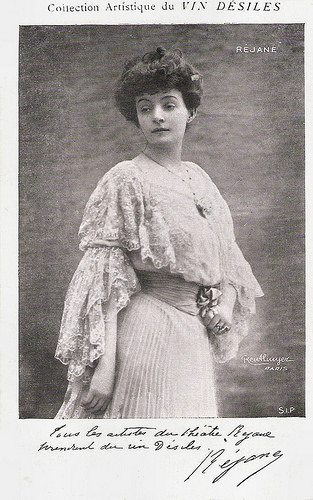
French postcard by S.I.P., for Vins Désiles. Photo: Reutlinger, Paris.
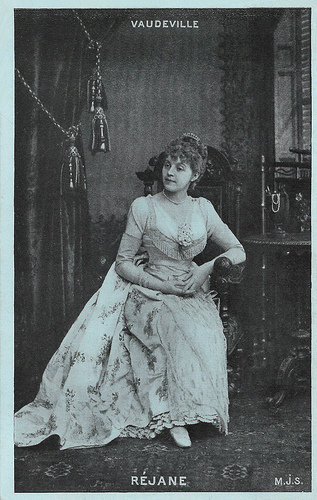
French postcard by M.J.S. Caption: Vaudeville.
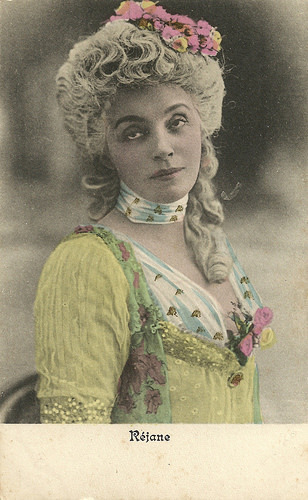
French [?] postcard, Series 129.
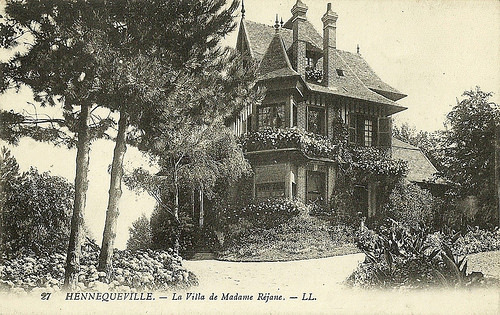
French postcard, no. 27. Caption: Hennequeville - La Villa de Madame Réjane. L.L.
Sources: Kit and Morgan Benson (Find A Grave), Wikipedia and .

French postcard by S.I.P., 34e serie, no. 9. Photo: Reutlinger, Paris.

French postcard, no. 1342. Photo Reutlinger, Paris. Mailed in 1905.

French postcard by S.I.P., no. 1874. Photo: Reutlinger, Paris. Mailed in 1911.

French postcard by S.I.P.. Photo Reutlinger, Paris. Caption: Vaudeville.
An emotional actress of rare gifts
Gabrielle Réjane was born as Gabrielle-Charlotte Reju in 1856 in Paris. She was the daughter of an actor.
She became a pupil of Régnier at the Conservatoire, and took the second prize for comedy in 1874. Her debut was the next year, during which she played a number of light — especially soubrette — parts.
Her first great success was in Henri Meilhac's Ma camarade (1883), in which she expressed her emotional sympathy to gain great audience appeal. She soon became known as an emotional actress of rare gifts, notably in Décor, Germinie Lacerteux, Ma cousine, Amoureuse and Lysistrata.
In 1892 a pregnant Réjane married Paul Porel, the director of the Théâtre du Vaudeville, but the marriage dissolved in 1905. Their only child was a daughter Germaine.
In 1893 she appeared in Paris, and soon thereafter in London and New York, in her most famous role as Catherine in Victorien Sardou's Madame Sans-Gêne. Her performances in the play made her as well known in England and the United States as in Paris, and in later years she appeared in characteristic parts in both countries, being particularly successful in Zaza and La Passerelle.

French postcard by Raphael Tuck & Fils, Editeurs, Paris, Série 200. Photo: publicity still for the stage play Madame Sans-Gêne. Caption: Victorien Sardou, madame Réjane and Léon Porel signing the contract for Madame Sans-Gêne.

French postcard by Raphael Tuck & Fils, Editeurs, Paris, Série 200. Photo: publicity still for the stage play Madame Sans-Gêne.

French postcard by Raphael Tuck & Fils, Editeurs, Paris, Série 200. Photo: publicity still for the stage play Madame Sans-Gêne.
French vivacity and animated expression
In 1906, Gabrielle Réjane opened the Théâtre Réjane, where she continued to act as well as manage the theatre.
Along with Sarah Bernhardt , she served as the model for the character of the actress Berma in Marcel Proust's novel In Search of Lost Time (A la Recherche du Temps Perdu).
The French vivacity and animated expression that was Réjane's trademark made her unrivalled in the parts which she had made her own.
She appeared in several short films during the early years of cinema, including an experimental 1908 sound film for Gaumont. She made two short and silent film adaptations of her greatest success, Madame Sans-Gêne (Clément Maurice, 1900) and Madame Sans-Gêne (André Calmettes, Henri Desfontaines 1911).
Her other films included Britannicus (André Calmettes, 1908) with Jean Mounet-Sully , the propaganda film Alsace (Henri Pouctal, 1916), and Miarka, la fille à l'ourse/Gypsy Passion (Louis Mercanton, 1920) starring Desdemona Mazza and Ivor Novello .

French postcard by S.I.P., no. 2. Photo: Reutlinger, Paris.

French postcard by S.I.P., 75th Series, no. 4. Photo: Reutlinger, Paris.

French postcard by S.I.P., 85th Series, no. 7. Photo: Reutlinger, Paris.

French postcard by S.I.P., no. 118/19. Photo: Reutlinger, Paris.
The Marseillaise on the tomb of her son
In Alsace (Henri Pouctal, 1916), a film that luckily still survives, Gabrielle Réjane reprised the role Gaston Leroux had written for her as stage play, with which she had been very successful in early 1913 at her own theatre.
Two families, one, French, one German, rival each other in the contested province of the Alsace. The French son ( Albert Dieudonné ) falls in love with the daughter of the Germans, Marguerite (Francesca Flory), but his mother (Réjane) tries to prevent the marriage plans.
When he falls ill, she gives in. When war breaks out, he must choose between his German fiancee and his French mother. Both women are fanatics and plotters, the man instead is weak. He is beaten up by a German mob and dies in his mother's arms.
When the film premiered at the Paris Gaumont-Palace, it was a massive success, especially for the final image of Réjane posing as the Marseillaise on the tomb of her son.
The full film, a tinted version found and restored by the Dutch EYE Filmmuseum, and containing English intertitles, can be watched on European Film Gateway
Gabrielle Réjane was made a Knight of the Legion of Honour three months before her death. She died in Paris in 1920 and was buried there in the Cimetière de Passy.

French postcard. Photo Reutlinger, Paris, No. 86/19. S.I.P. Mailed in 1904.

French postcard by S.I.P. Photo Reutlinger, Paris. Mailed in 1906.

French postcard by S.I.P., for Vins Désiles. Photo: Reutlinger, Paris.

French postcard by M.J.S. Caption: Vaudeville.

French [?] postcard, Series 129.

French postcard, no. 27. Caption: Hennequeville - La Villa de Madame Réjane. L.L.
Sources: Kit and Morgan Benson (Find A Grave), Wikipedia and .
Published on May 06, 2018 22:00
May 5, 2018
Karin Hardt
German actress Karin Hardt (1910-1992) made her cinema debut as a pure and disarmingly natural backfisch, looking for happiness. Her impressive career with many film, theatre and television appearances lasted for six decades.
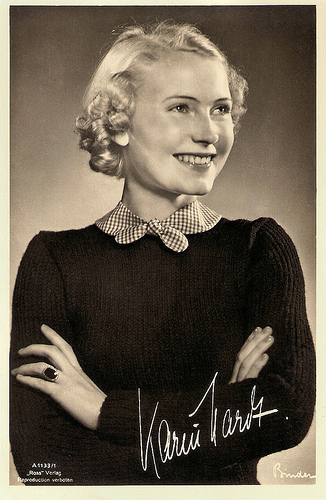
German postcard by Ross Verlag, no. A 1133/1, 1937-1938. Photo: Alex Binder.

German postcard by Ross Verlag, no. 7438/1, 1932-1933. Photo: Atelier Jacobi, Berlin.

German postcard by Ross Verlag, no. 7340/1, 1932-1933. Photo: Atelier Binder, Berlin.
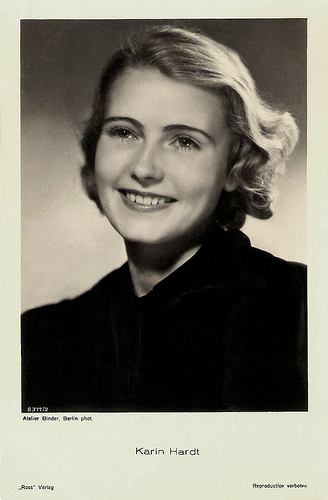
German postcard by Ross Verlag, no. 8377/2, 1934-1935. Photo: Atelier Binder, Berlin.
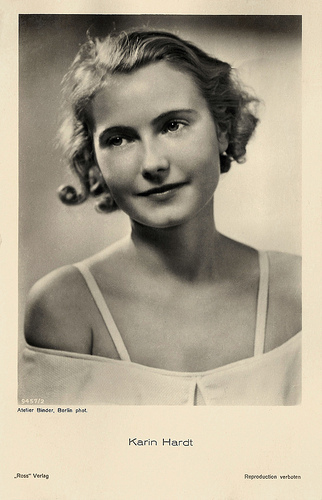
German postcard by Ross Verlag, no. 9457/2, 1935-1936. Photo: Atelier Binder, Berlin.
Disarmingly Natural
Karin Therese Meta Hardt was born in Altona (now Hamburg), Germany in 1910. She was a daughter of a merchant.
She had private acting lessons with Alex Otto and soon had theatre engagements in Mönchengladbach, Rheydt and Altenburg.
In 1931 she made her film debut in Vater geht auf Reisen/father Goes To Travel (Carl Boese, 1931) with Lissi Arna .
She was then discovered by director Erich Waschneck, who cast her in Acht Mädels im Boot/Eight Girls in a Boat (Erich Waschneck, 1932), which became her breakthrough.
She was the pure and disarmingly natural backfisch, who in a girly way angled for happiness.
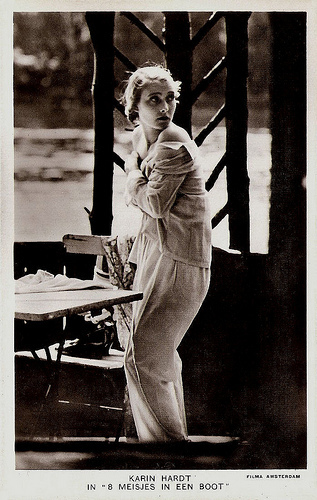
Dutch postcard by M. Bonnist & Zonen, Amsterdam, no. 146. Photo: Filma, Amsterdam. Still from Acht Mädels im Boot/Eight Girls in a Boat (1932).
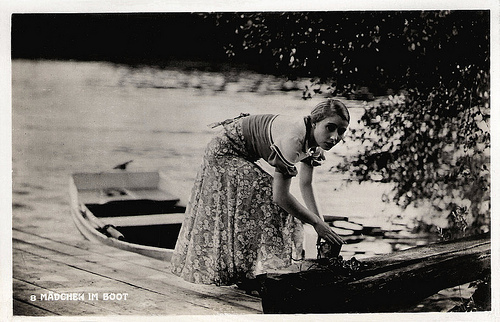
Dutch postcard by JosPe, Arnhem. Publicity still for Acht Mädels im Boot/Eight Girls in a Boat (Erich Waschneck, 1932).
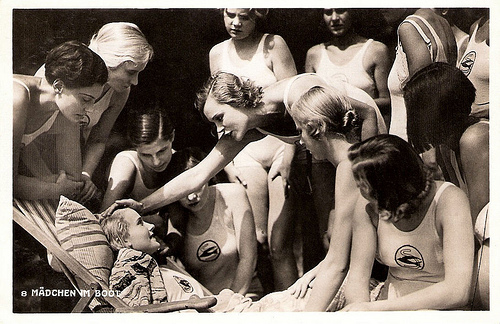
Dutch postcard by JosPe. Photo: still from Acht Mädels im Boot/Eight Girls in a Boat (1932).
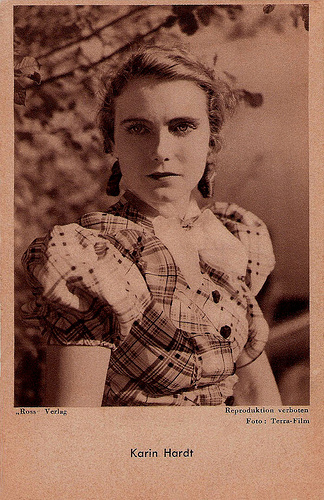
German postcard by Ross Verlag. Published for Das Programm von Heute für Film und Theater G.m.b.H, Stuttgart. Photo: Terra-Film.
Naive, Blonde Competitor
In the following years Karin Hardt became a beloved star.
Karin Hardt and Erich Waschneck married in 1933, and he would go on to direct her in some of their best films, including An heiligen Wassern/Sacred Waters (1932) and Abel mit der Mundharmonika/Abel with the Mouth Organ (1933).
Among her best known films in the following years belong Ein gewisser Herr Gran/A Certain Mr. Gran (Gerhard Lamprecht, 1933) next to Hans Albers, Die blonde Christel/Blonde Christel (Frans Seitz, 1933), and Barcarole (Gerhard Lamprecht, 1935).
In the second half of the 1930s followed Die Umwege des schönen Karl/The Diversions of Handsome Karl (Carl Froelich, 1938) with Heinz Rühmann , and Menschen vom Variete/Vaudeville People (Josef von Báky, 1939) as the naive, blonde competitor of La Jana .
During the war years her engagements became less, but Karin Hardt appeared for example in films like Kameraden/Comrades (Hans Schweikart, 1941) with Willy Birgel , Das Hochzeitshotel/The Marriage Hotel (Carl Boese, 1944), and Via Mala (Josef von Báky, 1944-1948) as the daughter of Carl Wery.
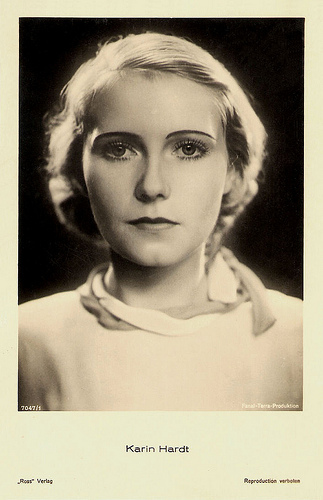
German postcard by Ross Verlag, no. 7047/1, 1932-1933. Photo: Fanal / Terra Produktion.
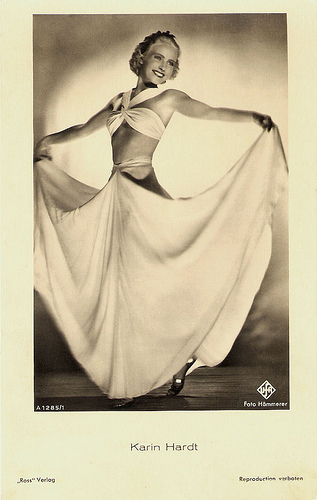
German postcard by Ross Verlag, no. A 1285/1, 1941-1944. Photo: Hämmerer / UFA.
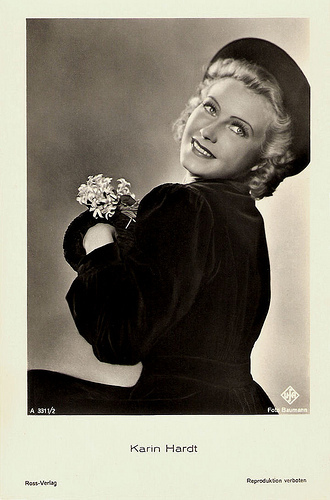
German postcard by Ross Verlag, no. A 3311/2, 1941-1944. Photo: Baumann / UFA.
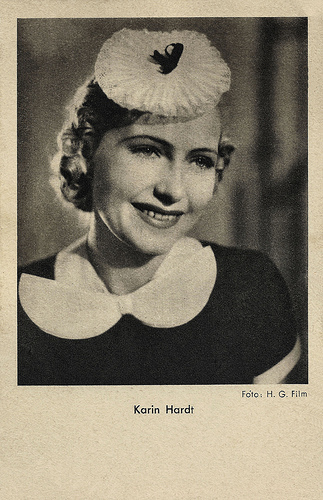
German postcard by Das Programm von Heute / Ross Verlag, Berlin. Photo: H.G. Film.
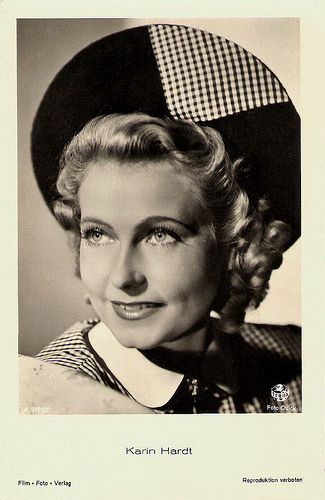
German postcard by Film-Foto-Verlag, no. A 3491/1, 1941-1944. Photo: Quick / Terra.
David Bowie
After the war, Karin Hardt was again regularly seen in the cinema. Erich Waschneck directed her in the comedy Danke es geht mir gut/Thanks, I’m alright (1948).
She appeared as the the queen in the fairytale film Dornröschen/Sleeping Beauty (Fritz Genschow, 1955), next to Horst Buchholz in Endstation Liebe/Last Stop Love (Georg Tressler, 1957), and with Kirk Douglas in Town Without Pity (Gottfried Reinhardt, 1961).
She mainly appeared in the theatre, in Berlin, Hamburg, Aachen and in Köln (Cologne). From the 1960s on she was also often seen on television, in TV-series like Bei uns zu Haus/At Our Home (1963), Der Forellenhof/The Trout Farm (1965) and Die Unternehmungen des Herrn Hans/The Enterprises of Mr. Hans (Charles Kerremans, 1976).
Hardt also appeared in the film Schöner Gigolo, armer Gigolo/Just a Gigolo (David Hemmings, 1979) with David Bowie . In 1983 she was awarded with the Filmband in Gold for her continuing attributions to the German cinema.
Then she had a great comeback in the popular serial Die Schwarzwaldklinik/The Black Forest Clinic (1985-1986). She played the housekeeper of the Brinkmann family, the owners of the clinic.
Karin Hardt died of cerebral hemorrhage in 1992 in Berlin. She was married twice. First to Erich Waschneck from 1933 till his death in 1970, and then to Rolf von Goth .
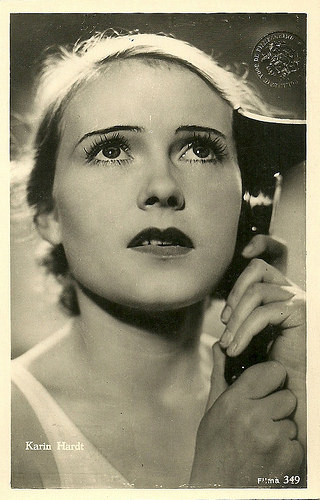
Dutch postcard by Jospé, Arnhem, no. 349. Photo: Filma. Dutch censorship mark at the right.
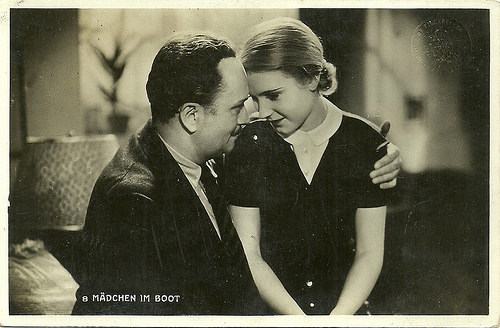
Dutch postcard (with Dutch censorship mark on the right) by Jospé, Arnhem. Photo: Theodor Loos (Baumeister Engelhardt) and Karin Hardt (Christa) in Acht Mädels im Boot/Eight Girls in a Boat (Erich Waschneck 1932), presented here as 8 Mädchen im Boot. The film was remade in the Netherlands in 1958 as Jenny (Willy van Hemert, 1958).
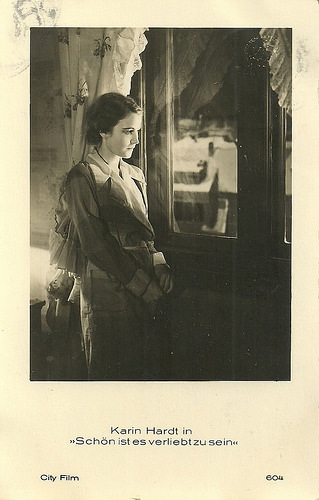
Dutch postcard by City Film, no. 604. Photo: Karin Hardt in the film Schön ist es verliebt zu sein/It's Great to Be in Love (Walter Janssen, 1933-1934).
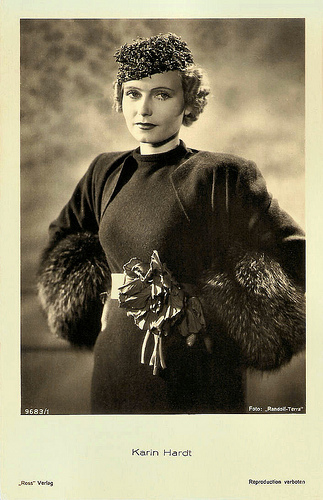
German postcard by Ross Verlag, no. 9683/1, 1935-1936. Photo: Randolf / Terra. Publicity still for Der Abenteurer von Paris/The Paris Adventure (Karl Heinz Martin, 1936).
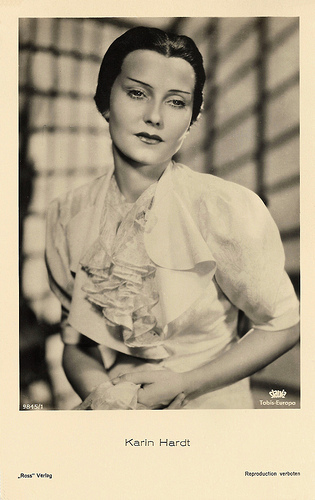
German postcard by Ross Verlag, no. 9945/1, 1935-1936. Photo: Tobis Europa / Slavia. Publicity still for Port Arthur (Nicolas Farkas, 1936).
Sources: Thomas Staedeli (Cyranos), Wikipedia (German), Schwarzwald-TV-Klinik (German), and .

German postcard by Ross Verlag, no. A 1133/1, 1937-1938. Photo: Alex Binder.

German postcard by Ross Verlag, no. 7438/1, 1932-1933. Photo: Atelier Jacobi, Berlin.

German postcard by Ross Verlag, no. 7340/1, 1932-1933. Photo: Atelier Binder, Berlin.

German postcard by Ross Verlag, no. 8377/2, 1934-1935. Photo: Atelier Binder, Berlin.

German postcard by Ross Verlag, no. 9457/2, 1935-1936. Photo: Atelier Binder, Berlin.
Disarmingly Natural
Karin Therese Meta Hardt was born in Altona (now Hamburg), Germany in 1910. She was a daughter of a merchant.
She had private acting lessons with Alex Otto and soon had theatre engagements in Mönchengladbach, Rheydt and Altenburg.
In 1931 she made her film debut in Vater geht auf Reisen/father Goes To Travel (Carl Boese, 1931) with Lissi Arna .
She was then discovered by director Erich Waschneck, who cast her in Acht Mädels im Boot/Eight Girls in a Boat (Erich Waschneck, 1932), which became her breakthrough.
She was the pure and disarmingly natural backfisch, who in a girly way angled for happiness.

Dutch postcard by M. Bonnist & Zonen, Amsterdam, no. 146. Photo: Filma, Amsterdam. Still from Acht Mädels im Boot/Eight Girls in a Boat (1932).

Dutch postcard by JosPe, Arnhem. Publicity still for Acht Mädels im Boot/Eight Girls in a Boat (Erich Waschneck, 1932).

Dutch postcard by JosPe. Photo: still from Acht Mädels im Boot/Eight Girls in a Boat (1932).

German postcard by Ross Verlag. Published for Das Programm von Heute für Film und Theater G.m.b.H, Stuttgart. Photo: Terra-Film.
Naive, Blonde Competitor
In the following years Karin Hardt became a beloved star.
Karin Hardt and Erich Waschneck married in 1933, and he would go on to direct her in some of their best films, including An heiligen Wassern/Sacred Waters (1932) and Abel mit der Mundharmonika/Abel with the Mouth Organ (1933).
Among her best known films in the following years belong Ein gewisser Herr Gran/A Certain Mr. Gran (Gerhard Lamprecht, 1933) next to Hans Albers, Die blonde Christel/Blonde Christel (Frans Seitz, 1933), and Barcarole (Gerhard Lamprecht, 1935).
In the second half of the 1930s followed Die Umwege des schönen Karl/The Diversions of Handsome Karl (Carl Froelich, 1938) with Heinz Rühmann , and Menschen vom Variete/Vaudeville People (Josef von Báky, 1939) as the naive, blonde competitor of La Jana .
During the war years her engagements became less, but Karin Hardt appeared for example in films like Kameraden/Comrades (Hans Schweikart, 1941) with Willy Birgel , Das Hochzeitshotel/The Marriage Hotel (Carl Boese, 1944), and Via Mala (Josef von Báky, 1944-1948) as the daughter of Carl Wery.

German postcard by Ross Verlag, no. 7047/1, 1932-1933. Photo: Fanal / Terra Produktion.

German postcard by Ross Verlag, no. A 1285/1, 1941-1944. Photo: Hämmerer / UFA.

German postcard by Ross Verlag, no. A 3311/2, 1941-1944. Photo: Baumann / UFA.

German postcard by Das Programm von Heute / Ross Verlag, Berlin. Photo: H.G. Film.

German postcard by Film-Foto-Verlag, no. A 3491/1, 1941-1944. Photo: Quick / Terra.
David Bowie
After the war, Karin Hardt was again regularly seen in the cinema. Erich Waschneck directed her in the comedy Danke es geht mir gut/Thanks, I’m alright (1948).
She appeared as the the queen in the fairytale film Dornröschen/Sleeping Beauty (Fritz Genschow, 1955), next to Horst Buchholz in Endstation Liebe/Last Stop Love (Georg Tressler, 1957), and with Kirk Douglas in Town Without Pity (Gottfried Reinhardt, 1961).
She mainly appeared in the theatre, in Berlin, Hamburg, Aachen and in Köln (Cologne). From the 1960s on she was also often seen on television, in TV-series like Bei uns zu Haus/At Our Home (1963), Der Forellenhof/The Trout Farm (1965) and Die Unternehmungen des Herrn Hans/The Enterprises of Mr. Hans (Charles Kerremans, 1976).
Hardt also appeared in the film Schöner Gigolo, armer Gigolo/Just a Gigolo (David Hemmings, 1979) with David Bowie . In 1983 she was awarded with the Filmband in Gold for her continuing attributions to the German cinema.
Then she had a great comeback in the popular serial Die Schwarzwaldklinik/The Black Forest Clinic (1985-1986). She played the housekeeper of the Brinkmann family, the owners of the clinic.
Karin Hardt died of cerebral hemorrhage in 1992 in Berlin. She was married twice. First to Erich Waschneck from 1933 till his death in 1970, and then to Rolf von Goth .

Dutch postcard by Jospé, Arnhem, no. 349. Photo: Filma. Dutch censorship mark at the right.

Dutch postcard (with Dutch censorship mark on the right) by Jospé, Arnhem. Photo: Theodor Loos (Baumeister Engelhardt) and Karin Hardt (Christa) in Acht Mädels im Boot/Eight Girls in a Boat (Erich Waschneck 1932), presented here as 8 Mädchen im Boot. The film was remade in the Netherlands in 1958 as Jenny (Willy van Hemert, 1958).

Dutch postcard by City Film, no. 604. Photo: Karin Hardt in the film Schön ist es verliebt zu sein/It's Great to Be in Love (Walter Janssen, 1933-1934).

German postcard by Ross Verlag, no. 9683/1, 1935-1936. Photo: Randolf / Terra. Publicity still for Der Abenteurer von Paris/The Paris Adventure (Karl Heinz Martin, 1936).

German postcard by Ross Verlag, no. 9945/1, 1935-1936. Photo: Tobis Europa / Slavia. Publicity still for Port Arthur (Nicolas Farkas, 1936).
Sources: Thomas Staedeli (Cyranos), Wikipedia (German), Schwarzwald-TV-Klinik (German), and .
Published on May 05, 2018 22:00
May 4, 2018
André Nox
André Nox (1869-1946) was a French actor who worked in the cinema from 1916 till 1940. During the silent era he starred in French and German films. After the sound film was introduced he mainly played supporting parts.
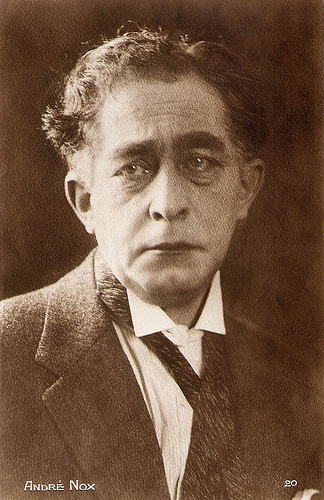
French postcard by Editions Cinémagazine, no. 20.
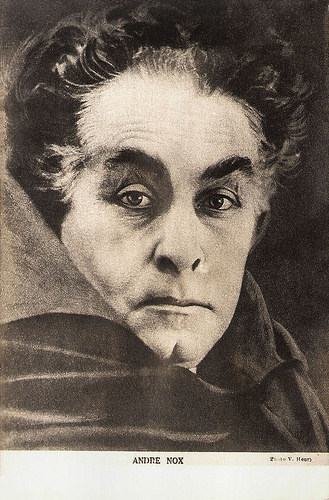
French postcard. Photo: V. Henry.
The perfect interpreter of poignant dramas
André Nox was born as Abraham André Nonnes-Lopes in 1869 in Paris, France. He was sometimes credited as André Nonnez. He came from a family of Jewish notables, and was the nephew of dramaturge and author Georges de Porto-Riche.
After his studies, he worked in finance before joining the army at the very beginning of the First World War. Demobilised in 1916, when he was about fifty, he abandoned his business to try a career in cinema which was booming at the time.
He made his cinema debut for Les Films Succès in the short silent film Sous les phares/Under the lights (1916), directed by André Hugon. He next starred in the silent Western Les chacals/The Jackals (André Hugon, 1917), also starring Louis Paglieri and Musidora .
For Huron, he also appeared in Vertige/Vertigo (André Hugon, 1917) starring Régine Marco, the crime film Requins/Sharks (André Hugon, 1917) starring Charles Krauss, Johannes, fils de Johannes/Johannes, Son of Johannes (André Huron, Louis Paglieri, 1918) with Musidora , and La Fugitive/The Fugitive (André Hugon, 1920) starring Marie-Louise Derval.
He signed a contract with Gaumont and acted in Léon Poirier's Âme de Orient/Soul of the Orient (1919), filmed in Nice with Madeleine Sève, Charles Dullin and the very young Josette Day . Then he played in Poirier’s Le Penseur/The Thinker (Leon Poirier, 1920), a philosophical drama based on an idea of Edmond Fleg, with Marguerite Madys and Armand Tallier.
Pascal Donald at CinéArtistes calls it “certainly his best role (…) With his pepper and salt hair often shaggy, his face with powerful features and his dark eyes, he is the perfect interpreter of poignant dramas.”
For Germaine Dulac, Nox appeared in her La mort du soleil/The Death of the Sun (1922). He played a musician in Le quinzième prélude de Chopin/The fifteenth prelude of Chopin (Victor Tourjanski, 1922).
In 1925, he appeared opposite Conrad Veidt in the French silent historical film Le comte Kostia/Count Kostia (Jacques Rober, 1925), set in Tsarist Russia. He had a supporting part in the drama La femme nue/The Nude Woman (Léonce Perret, 1926) starring Iván Petrovich , Louise Lagrange and Nita Naldi, and based on a play by Henry Bataille.
In Germany, he appeared with Carmen Boni , Werner Krauss and S.Z. Szakall in the silent film Der fidele Bauer/The Merry Farmer (Franz Seitz, 1927), based on the 1907 operetta of the same title, and in Die Hölle der Jungfrauen/The Hell of Virgins (Robert Dinesen, 1928) with Werner Krauss and Elizza La Porta .
Back in France, he appeared with Betty Balfour and Jaque Catelain in the drama Le diable au Coeur/Little Devil May Care (Marcel L'Herbier, 1928). One of his best films is Verdun, visions d'histoire/Verdun, Historical Visions (Léon Poirier, 1928), a dramatic re-enactment of the battle of Verdun during World War I, as seen by both French and German sides. In Germany he also made the silent drama S.O.S. Schiff in Not/Ship in Distress (Carmine Gallone, 1929) starring Liane Haid , Alphons Fryland and Gina Manès .
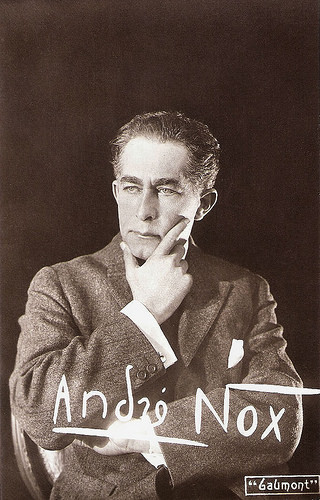
French postcard. Photo: Gaumont.
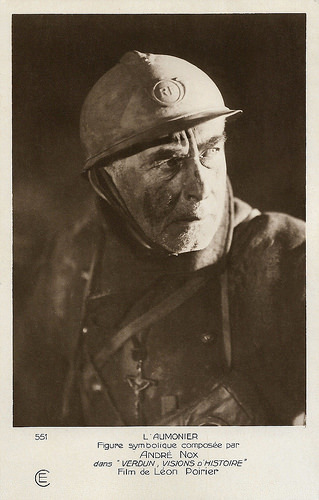
French postcard by Editions Cinémagazine, no. 551. Photo: André Nox as L'aumonier (The chaplain) in Léon Poirier's silent film Verdun, visions d'histoire/Verdun, historical visions (1928).
Hedy Lamarr's father in Extase
André Nox could make the step to sound films. He played Hedy Lamarr’s father in Extase/Ecstasy (Gustav Machatý, 1933), which became a sensation because of a daring sex scene.
In 1933 he had a part in the French-German Science Fiction film Le tunnel/The Tunnel (Kurt (Curtis) Bernhardt, 1933), starring Jean Gabin , Madeleine Renaud and Robert Le Vigan . It was the French language version of the German film Der Tunnel, with a different cast and some changes to the plot. Both were followed in 1935 by an English version.
Such Multiple-language versions were common in the years immediately following the introduction of sound, before the practice of dubbing had come to dominate international releases. Germany and France made a significant number of films together at this time.
The film is an adaptation of Bernhard Kellermann's 1913 novel Der Tunnel about the construction of a vast tunnel under the Atlantic Ocean connecting Europe and America. The film's Jewish director Kurt Bernhardt had fled Germany following the Nazi takeover, but returned briefly to shoot exterior scenes after being granted special permission by the German government.
Nox also appeared in the drama L'Appel du Silence/The Call of Silence (Léon Poirier, 1936), with Jean Yonnel as the Catholic missionary Charles de Foucauld, who traveled the Sahara and was killed by local bandits.
A success was Un grand amour de Beethoven/The Life and Loves of Beethoven (Abel Gance, 1936) a lyrical biography of the classical composer played by Harry Baur . Nox reunited with director-writer Marcel L’Herbier for the dramas Nuits de feu/Nights of Fire (Marcel L'Herbier, 1937), starring Gaby Morlay and La citadelle du silence/The Citadel of Silence (Marcel L'Herbier, 1937), starring Annabella .
He also had a supporting part in the war film J'accuse!/I Accuse (Abel Gance, 1938) starring Victor Francen . It is a remake of the 1919 film of the same name, which was also directed by Abel Gance .
Nox also appeared with Dita Parlo and Erich von Stroheim in the French historical drama Ultimatum (Robert Wiene, Robert Siodmak, 1938). With his friend Léon Poirier, André Nox made in Equatorial Africa what turned out to be his final film, Brazza ou l'épopée du Congo/Brazza or the epic of Congo (Léon Poirier, 1940).
On his return from Africa, France was at war. The defeat in June 1940 and the rise of anti-Semitism forced Nox to withdraw to Brittany.
André Nox died on 25 February 1946, a few months after the liberation. He did not get the time to return to the cinema. Nox was 76. His son was the actor Pierre Nonnez-Lopès (1898-1978), known as Pierre Nay.
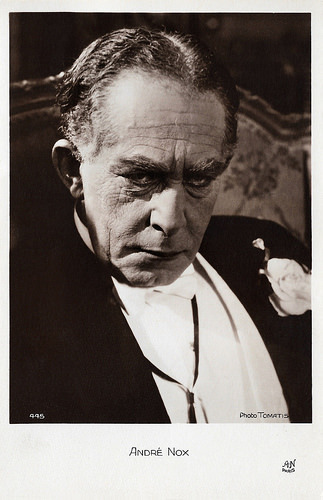
French postcard by A.N., Paris, no. 445. Photo: R. Tomatis. Publicity still for La Possession/Ownership (Léonce Perret, 1929).
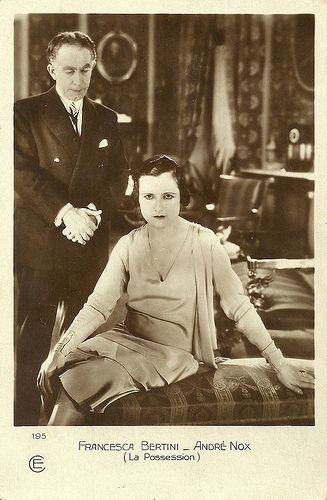
French postcard by Editions Cinémagazine, no. 195. Photo: Francesca Bertini and André Nox in La Possession (Léonce Perret 1929).
Sources: Pascal Donald (CinéArtistes – French), Wikipedia (French and English) and .

French postcard by Editions Cinémagazine, no. 20.

French postcard. Photo: V. Henry.
The perfect interpreter of poignant dramas
André Nox was born as Abraham André Nonnes-Lopes in 1869 in Paris, France. He was sometimes credited as André Nonnez. He came from a family of Jewish notables, and was the nephew of dramaturge and author Georges de Porto-Riche.
After his studies, he worked in finance before joining the army at the very beginning of the First World War. Demobilised in 1916, when he was about fifty, he abandoned his business to try a career in cinema which was booming at the time.
He made his cinema debut for Les Films Succès in the short silent film Sous les phares/Under the lights (1916), directed by André Hugon. He next starred in the silent Western Les chacals/The Jackals (André Hugon, 1917), also starring Louis Paglieri and Musidora .
For Huron, he also appeared in Vertige/Vertigo (André Hugon, 1917) starring Régine Marco, the crime film Requins/Sharks (André Hugon, 1917) starring Charles Krauss, Johannes, fils de Johannes/Johannes, Son of Johannes (André Huron, Louis Paglieri, 1918) with Musidora , and La Fugitive/The Fugitive (André Hugon, 1920) starring Marie-Louise Derval.
He signed a contract with Gaumont and acted in Léon Poirier's Âme de Orient/Soul of the Orient (1919), filmed in Nice with Madeleine Sève, Charles Dullin and the very young Josette Day . Then he played in Poirier’s Le Penseur/The Thinker (Leon Poirier, 1920), a philosophical drama based on an idea of Edmond Fleg, with Marguerite Madys and Armand Tallier.
Pascal Donald at CinéArtistes calls it “certainly his best role (…) With his pepper and salt hair often shaggy, his face with powerful features and his dark eyes, he is the perfect interpreter of poignant dramas.”
For Germaine Dulac, Nox appeared in her La mort du soleil/The Death of the Sun (1922). He played a musician in Le quinzième prélude de Chopin/The fifteenth prelude of Chopin (Victor Tourjanski, 1922).
In 1925, he appeared opposite Conrad Veidt in the French silent historical film Le comte Kostia/Count Kostia (Jacques Rober, 1925), set in Tsarist Russia. He had a supporting part in the drama La femme nue/The Nude Woman (Léonce Perret, 1926) starring Iván Petrovich , Louise Lagrange and Nita Naldi, and based on a play by Henry Bataille.
In Germany, he appeared with Carmen Boni , Werner Krauss and S.Z. Szakall in the silent film Der fidele Bauer/The Merry Farmer (Franz Seitz, 1927), based on the 1907 operetta of the same title, and in Die Hölle der Jungfrauen/The Hell of Virgins (Robert Dinesen, 1928) with Werner Krauss and Elizza La Porta .
Back in France, he appeared with Betty Balfour and Jaque Catelain in the drama Le diable au Coeur/Little Devil May Care (Marcel L'Herbier, 1928). One of his best films is Verdun, visions d'histoire/Verdun, Historical Visions (Léon Poirier, 1928), a dramatic re-enactment of the battle of Verdun during World War I, as seen by both French and German sides. In Germany he also made the silent drama S.O.S. Schiff in Not/Ship in Distress (Carmine Gallone, 1929) starring Liane Haid , Alphons Fryland and Gina Manès .

French postcard. Photo: Gaumont.

French postcard by Editions Cinémagazine, no. 551. Photo: André Nox as L'aumonier (The chaplain) in Léon Poirier's silent film Verdun, visions d'histoire/Verdun, historical visions (1928).
Hedy Lamarr's father in Extase
André Nox could make the step to sound films. He played Hedy Lamarr’s father in Extase/Ecstasy (Gustav Machatý, 1933), which became a sensation because of a daring sex scene.
In 1933 he had a part in the French-German Science Fiction film Le tunnel/The Tunnel (Kurt (Curtis) Bernhardt, 1933), starring Jean Gabin , Madeleine Renaud and Robert Le Vigan . It was the French language version of the German film Der Tunnel, with a different cast and some changes to the plot. Both were followed in 1935 by an English version.
Such Multiple-language versions were common in the years immediately following the introduction of sound, before the practice of dubbing had come to dominate international releases. Germany and France made a significant number of films together at this time.
The film is an adaptation of Bernhard Kellermann's 1913 novel Der Tunnel about the construction of a vast tunnel under the Atlantic Ocean connecting Europe and America. The film's Jewish director Kurt Bernhardt had fled Germany following the Nazi takeover, but returned briefly to shoot exterior scenes after being granted special permission by the German government.
Nox also appeared in the drama L'Appel du Silence/The Call of Silence (Léon Poirier, 1936), with Jean Yonnel as the Catholic missionary Charles de Foucauld, who traveled the Sahara and was killed by local bandits.
A success was Un grand amour de Beethoven/The Life and Loves of Beethoven (Abel Gance, 1936) a lyrical biography of the classical composer played by Harry Baur . Nox reunited with director-writer Marcel L’Herbier for the dramas Nuits de feu/Nights of Fire (Marcel L'Herbier, 1937), starring Gaby Morlay and La citadelle du silence/The Citadel of Silence (Marcel L'Herbier, 1937), starring Annabella .
He also had a supporting part in the war film J'accuse!/I Accuse (Abel Gance, 1938) starring Victor Francen . It is a remake of the 1919 film of the same name, which was also directed by Abel Gance .
Nox also appeared with Dita Parlo and Erich von Stroheim in the French historical drama Ultimatum (Robert Wiene, Robert Siodmak, 1938). With his friend Léon Poirier, André Nox made in Equatorial Africa what turned out to be his final film, Brazza ou l'épopée du Congo/Brazza or the epic of Congo (Léon Poirier, 1940).
On his return from Africa, France was at war. The defeat in June 1940 and the rise of anti-Semitism forced Nox to withdraw to Brittany.
André Nox died on 25 February 1946, a few months after the liberation. He did not get the time to return to the cinema. Nox was 76. His son was the actor Pierre Nonnez-Lopès (1898-1978), known as Pierre Nay.

French postcard by A.N., Paris, no. 445. Photo: R. Tomatis. Publicity still for La Possession/Ownership (Léonce Perret, 1929).

French postcard by Editions Cinémagazine, no. 195. Photo: Francesca Bertini and André Nox in La Possession (Léonce Perret 1929).
Sources: Pascal Donald (CinéArtistes – French), Wikipedia (French and English) and .
Published on May 04, 2018 22:00
May 3, 2018
Ed. Ballerini & Fratini
One of the most renowned Italian postcard publishers was B.F.F. edit. Full name was Casa Editrice Ballerini & Fratini and the second F in the abbreviation came from Firenze, Florence in English, where the firm was located. Ballerini & Fratini started to publish film and film star postcards in the early 1920s when the Italian cinema was still booming. In the later 1920s, after the Italian film industry had collapsed, B.F.F. focused on international stars. Later they distributed in Italy star postcards from the French publisher Europe and the German Ross Verlag. In the 1930s, Italian film stars were popular again and till the end of the 1950s, B.F.F. issued thousands of star postcards. If the numbering on the postcards is chronological, we dare to question. However, Ballerini & Fratini still exists today and is still located in Florence.
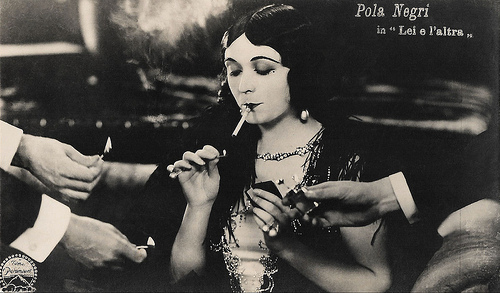
Italian postcard by Ed. Ballerini & Fratini, Firenze. Photo: Paramount. Publicity still of Pola Negri in Good and Naughty (Malcolm St. Clair, 1926).
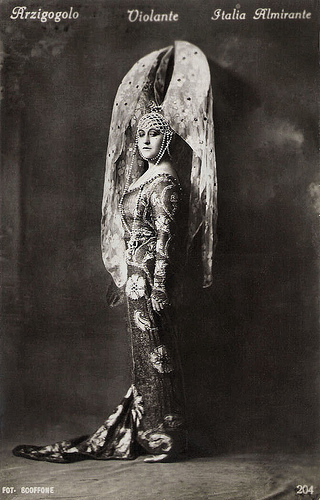
Italian postcard by Ballerini & Fratini, Firenze, no. 204. Photo Scoffone. Italia Almirante Manzini as Violante in the film L'Arzigogolo (Mario Almirante 1924), adaptation of the play by Sem Benelli.
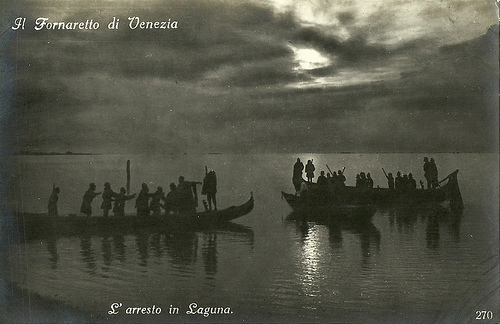
Italian postcard by Ballerini & Fratini, Firenze, no. 270. Photo: Alba Film. Publicity still for Il fornaretto di Venezia (Mario Almirante, 1923). Caption: The arrest in the laguna.
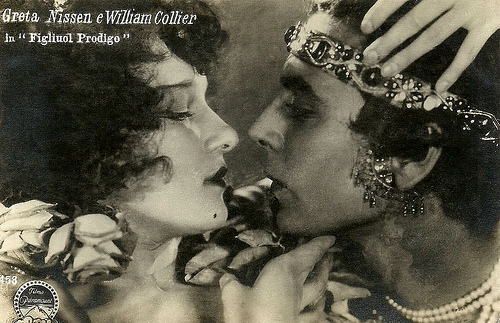
Italian postcard by Casa Editrice Ballerini & Fratini, Firenze (Florence), no. 458. Photo: SAI Filmo Paramount, Roma. Publicity still of Greta Nissen and William Collier in The Wanderer (Raoul Walsh, 1925). Collection: Didier Hanson.
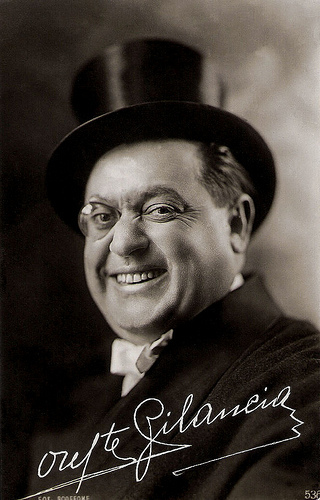
Oreste Bilancia . Italian postcard by Ballerini & Fratini, Firenze, no. 536. Photo Scoffone.
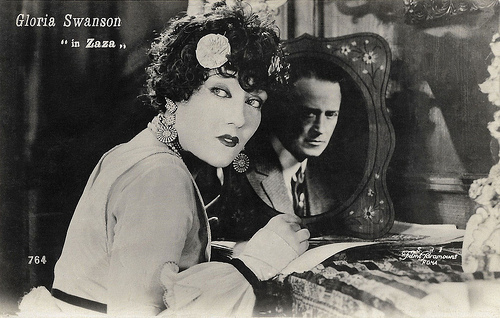
Italian postcard by Ed. Ballerini & Fratini, no. 764. Photo: SAI Filmo Paramount, Roma. Publicity still of Gloria Swanson in Zazà (Allan Dwan, 1923).
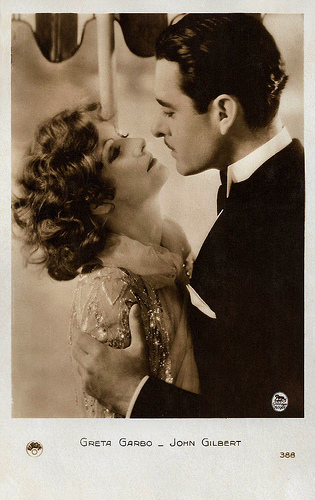
French postcard by Europe, no. 388, distributed in Italy by Casa Editrice Ballerini & Fratini, Firenze. Photo: James Manatt / Metro-Goldwyn-Mayer. Publicity still of Greta Garbo and John Gilbert in A Woman of Affairs (Clarence Brown, 1928).
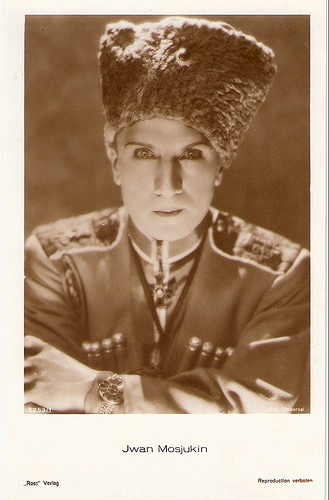
Ivan Mozzhukhin . German postcard by Ross Verlag, no. 5253/1, 1930-1931. Photo: Universal. Publicity still for Der weiße Teufel/The White Devil (Alexandre Volkoff, 1930). On the back of the card: Vendita esclusiva Casa Editrice Ballerini & Fratini, Firenze (125).
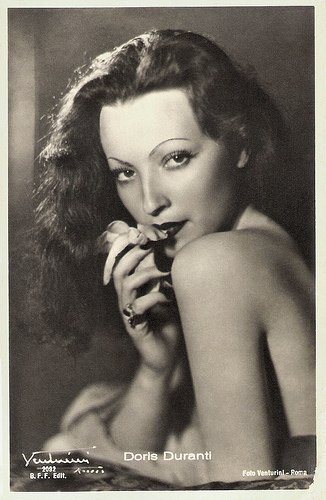
Doris Duranti. Italian postcard by B.F.F. Edit, no. 2092. Photo: Venturini, Roma.
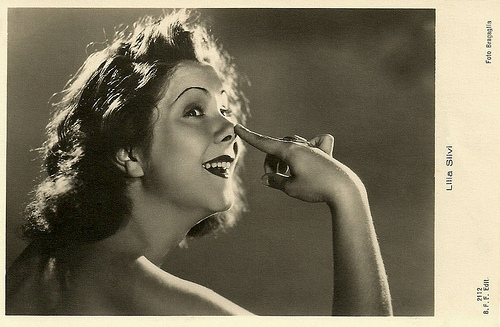
Lilia Silvi . Italian postcard by Ballerini & Fratini, Firenze, no. 2112. Photo: Bragaglia.
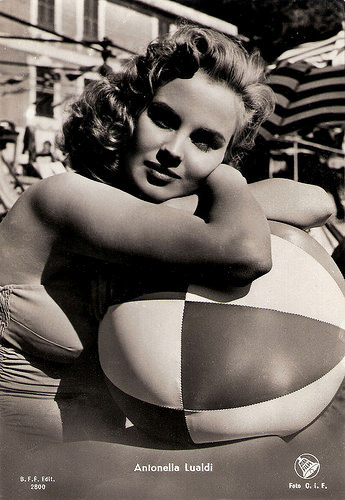
Antonella Lualdi . Italian postcard by B.F.F. Edit., no. 2800. Photo: Dear Film / C.I.F.
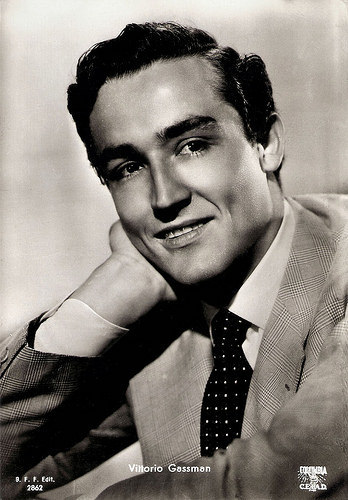
Vittorio Gassman . Italian postcard by Casa Editr. Ballerini & Fratini, Firenze (BFF), no. 2962. Photo: Columbia / CEIAD.
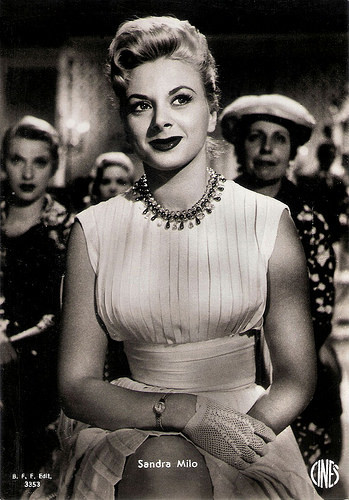
Sandra Milo . Italian postcard by B.F.F. Edit., no. 3353. Photo: Cines.
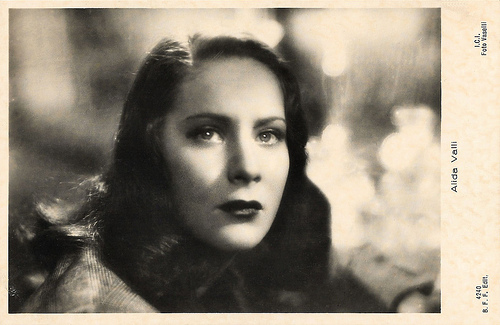
Alida Valli . Italian postcard by Ballerini & Fratini, Firenze (B.F.F. Edit.), no. 4240. Photo: I.C.I. / Vaselli.
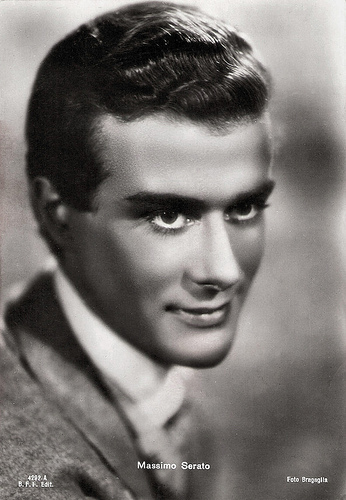
Massimo Serato. Italian postcard by B.F.F. Edit., no. 4242-A. Photo: Bragaglia.
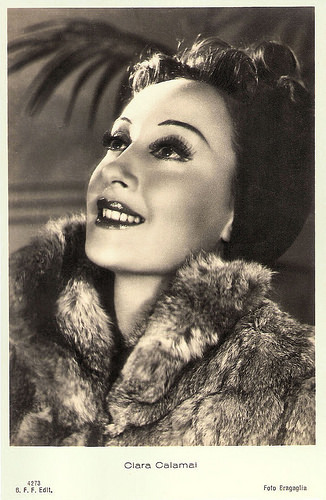
Clara Calamai . Italian postcard by Casa Editrice Ballerini & Fratini, Firenze, no. 4273. Photo: Bragaglia.
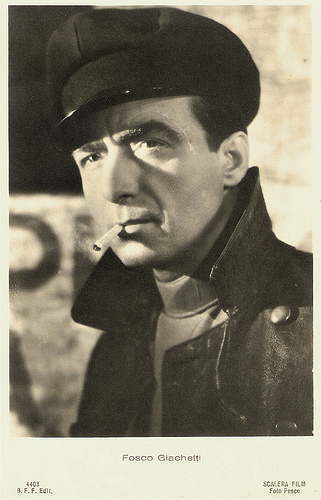
Fosco Giachetti . Italian postcard by B.F.F. Edit., no. 4423. Photo: Scalera Film / Pesce.
Sources: Garbo Forever and Virgilio (Italian).

Italian postcard by Ed. Ballerini & Fratini, Firenze. Photo: Paramount. Publicity still of Pola Negri in Good and Naughty (Malcolm St. Clair, 1926).

Italian postcard by Ballerini & Fratini, Firenze, no. 204. Photo Scoffone. Italia Almirante Manzini as Violante in the film L'Arzigogolo (Mario Almirante 1924), adaptation of the play by Sem Benelli.

Italian postcard by Ballerini & Fratini, Firenze, no. 270. Photo: Alba Film. Publicity still for Il fornaretto di Venezia (Mario Almirante, 1923). Caption: The arrest in the laguna.

Italian postcard by Casa Editrice Ballerini & Fratini, Firenze (Florence), no. 458. Photo: SAI Filmo Paramount, Roma. Publicity still of Greta Nissen and William Collier in The Wanderer (Raoul Walsh, 1925). Collection: Didier Hanson.

Oreste Bilancia . Italian postcard by Ballerini & Fratini, Firenze, no. 536. Photo Scoffone.

Italian postcard by Ed. Ballerini & Fratini, no. 764. Photo: SAI Filmo Paramount, Roma. Publicity still of Gloria Swanson in Zazà (Allan Dwan, 1923).

French postcard by Europe, no. 388, distributed in Italy by Casa Editrice Ballerini & Fratini, Firenze. Photo: James Manatt / Metro-Goldwyn-Mayer. Publicity still of Greta Garbo and John Gilbert in A Woman of Affairs (Clarence Brown, 1928).

Ivan Mozzhukhin . German postcard by Ross Verlag, no. 5253/1, 1930-1931. Photo: Universal. Publicity still for Der weiße Teufel/The White Devil (Alexandre Volkoff, 1930). On the back of the card: Vendita esclusiva Casa Editrice Ballerini & Fratini, Firenze (125).

Doris Duranti. Italian postcard by B.F.F. Edit, no. 2092. Photo: Venturini, Roma.

Lilia Silvi . Italian postcard by Ballerini & Fratini, Firenze, no. 2112. Photo: Bragaglia.

Antonella Lualdi . Italian postcard by B.F.F. Edit., no. 2800. Photo: Dear Film / C.I.F.

Vittorio Gassman . Italian postcard by Casa Editr. Ballerini & Fratini, Firenze (BFF), no. 2962. Photo: Columbia / CEIAD.

Sandra Milo . Italian postcard by B.F.F. Edit., no. 3353. Photo: Cines.

Alida Valli . Italian postcard by Ballerini & Fratini, Firenze (B.F.F. Edit.), no. 4240. Photo: I.C.I. / Vaselli.

Massimo Serato. Italian postcard by B.F.F. Edit., no. 4242-A. Photo: Bragaglia.

Clara Calamai . Italian postcard by Casa Editrice Ballerini & Fratini, Firenze, no. 4273. Photo: Bragaglia.

Fosco Giachetti . Italian postcard by B.F.F. Edit., no. 4423. Photo: Scalera Film / Pesce.
Sources: Garbo Forever and Virgilio (Italian).
Published on May 03, 2018 22:00
May 2, 2018
Else Elster
German actress and singer Else Elster (1910-1998) appeared in over forty films during the Weimar and Nazi eras.
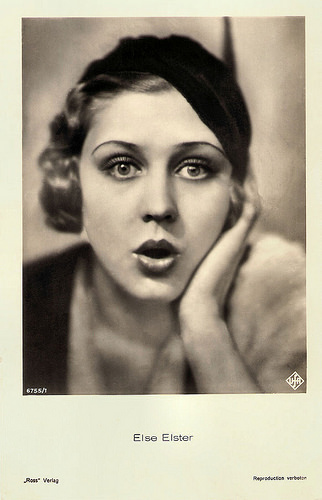
German postcard by Ross Verlag, no. 6755/1, 1931-1932. Photo: Ufa.
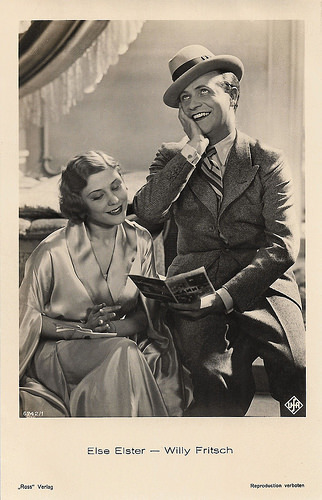
German postcard by Ross Verlag, no. 6742/1, 1931-1932. Photo: Ufa. Publicity still for Der Frechdachs/The Cheeky Devil (Carl Boese, Heinz Hille, 1932) with Willy Fritsch .
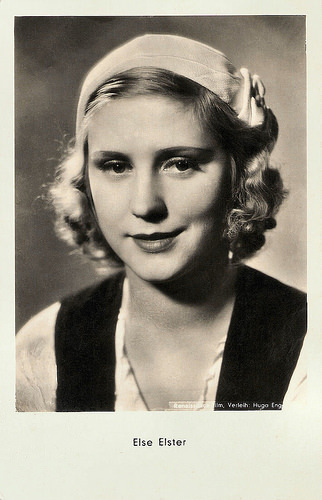
Austrian postcard by Iris Verlag, no. 6690. Photo: Renaissance Film / Verleih: Hugo Engel. Publicity still for Flucht nach Nizza/Escape to Nice (James Bauer, 1933).
Ridiculing China and the Chinese People
Else Elster was born in 1910 (some sources say 1912) in Danzig, Germany (now Gdansk, Poland).
She was trained by actress Ilka Grüning in Berlin and attended the Musikhochschule (music academy) in Vienna. Already before her exams she made her film debut in the musical Die blonde Nachtigall/The Blonde Nightingale (Johannes Meyer, 1930) as the daughter of Gustav Schubert (Ernst Behmer).
Despite starring in her film debut, she was primarily used as a second lead and supporting player in her next films like the hilarious comedy Der Herr auf Bestellung/Gentleman for Hire (Géza von Bolváry, 1930), the operetta Viktoria und ihr Husar /Victoria and Her Hussar (Richard Oswald, 1931) and the musical comedy Wochenend im Paradies/Weekend in Paradise (Robert Land, 1931) with Otto Wallburg and Claire Rommer .
The year 1932 was a very busy one for Else Elster. She took part in eight films, including Geheimnis des blauen Zimmers/The Secret of the Blue Room (Erich Engels, 1932), the comedy Der Frechdachs/The Cheeky Devil (Carl Boese, Heinz Hille, 1932) starring Willy Fritsch , and the thriller Tod über Shanghai/Death Over Shanghai (Rolf Randolf, 1932) starring Gerda Maurus .
The Chinese Ministry of Education requested that the German government have Tod über Shanghai/Death Over Shanghai (Rolf Randolf, 1932) destroyed because they had received reports that it "ridiculed China and the Chinese people".
That year, Elster also made her theatre debut and in the following years she impersonated many roles on stage. Like many other young actresses in the Third Reich, she was one of the celebrities with whom Adolf Hitler liked to show himself. She was one of the first TV announcers of the television station Paul Nipkow.
Her later films included the comedy Muß man sich gleich scheiden lassen/Must We Get Divorced? (Hans Behrendt, 1933) with Aribert Mog and Iván Petrovich , the romantic comedy Krach im Hinterhaus/Trouble Backstairs (Veit Harlan, 1935) starring Henny Porten , and the historical romance Drei Mäderl um Schubert/Three Girls for Schubert (E.W. Emo, 1936) with Paul Hörbiger as composer Franz Schubert.
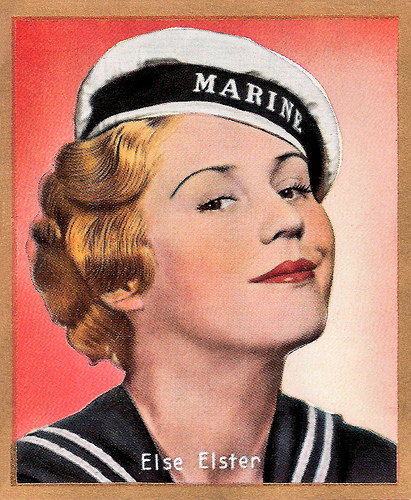
German cigarette card in the series Unsere Bunten Filmbilder by Ross Verlag for Cigarettenfabrik Josetti, Berlin, no. 153. Photo: Alex Binder.
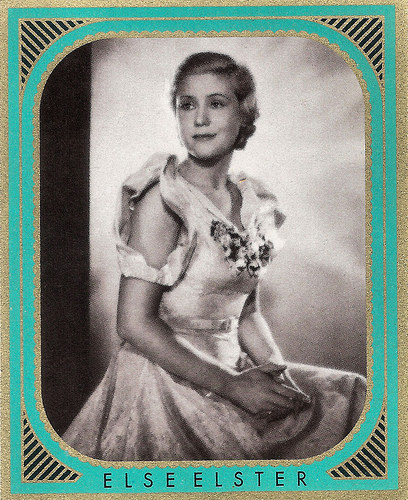
German collectors card in the Bunte Filmbilder series by Caid Zigaretten, Series no. 2, no. 323. Photo: Schulz and Wuellner / Ross-Verlag.
Her lover's execution
During the Second World War, Else Elster entered into a relationship with the Berlin police chief Wolf Heinrich Graf von Helldorf, who had joined the Stauffenberg group. Personal family records show that Elster marked the date of her lover's execution (15 August 1944) with a cross in her diary.
The farewell letter of Count Helldorf is still owned by the family and can be seen as a copy in the House of Resistance in Berlin. Already weeks before the execution she had to appear again and again for nightly Gestapo interrogations. In fact, she did not know anything about Count Helldorf's resistance plans.
Elster was pregnant by Helldorf and their daughter later was named Christa. After the war, Else Elster's filmmaking was practically over because of her close association with the Nazi regime and especially with Propaganda Minister Joseph Goebbels and also because her role in the notorious Nazi propaganda film Jud Süß (Veit Harlan, 1940) as the mistress of the title figure.
She only appeared in one more film, Nichts als Zufälle/Nothing but Coincidences (E.W. Emo, 1949) starring Theo Lingen . Nevertheless, she continued to work as a stage actress, cabaret artist and singer, but without her former success.
Later she married the gynecologist dr. Erhard Schlaegel and moved with him in his villa in Günzburg. Her husband brought two children into the marriage and in 1950, Else Schlaegel gave birth to her son Wolf Wilhelm Schlaegel. Together with her husband, she worked for the next few years in the gynaecological clinic.
In 1996, Erhard Schlaegel died shortly after the birth of his grandchild. Else Schlaegel lived for another two years in an apartment in Günzburg, before she died in 1998. Both spouses are buried in the family grave of the family Schlaegel in the Günzburger cemetery. Her son Wolf Wilhelm Schlaegel became a specialist in rehabilitation and now lives with his family in his parents' home in Günzburg. He granted the museum House of Resistance in Berlin an insight into his mother's personal files.
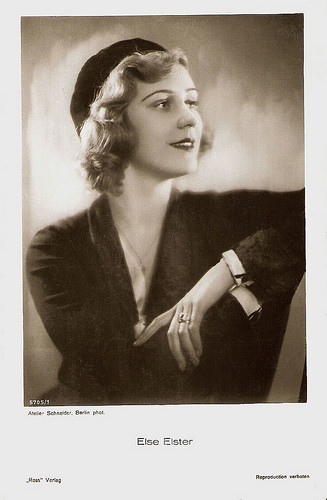
German postcard by Ross Verlag, no. 5705/1, 1930-1931. Photo: Atelier Schneider.
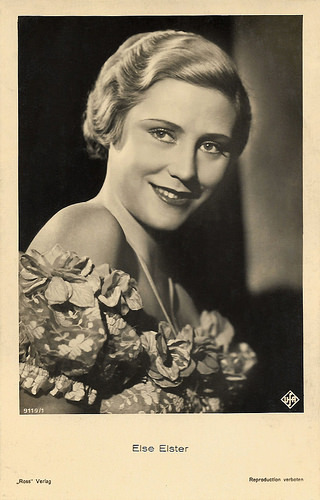
German postcard by Ross Verlag, no. 9119/1, 1935-1936. Photo: UFA.
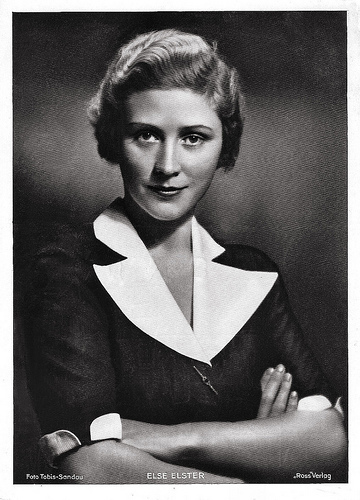
Big German card by Ross Verlag. Photo: Tobis / Sandau.
Sources: Stephanie D'heil (Steffi-Line.de – German), Wikipedia (German and English), and .

German postcard by Ross Verlag, no. 6755/1, 1931-1932. Photo: Ufa.

German postcard by Ross Verlag, no. 6742/1, 1931-1932. Photo: Ufa. Publicity still for Der Frechdachs/The Cheeky Devil (Carl Boese, Heinz Hille, 1932) with Willy Fritsch .

Austrian postcard by Iris Verlag, no. 6690. Photo: Renaissance Film / Verleih: Hugo Engel. Publicity still for Flucht nach Nizza/Escape to Nice (James Bauer, 1933).
Ridiculing China and the Chinese People
Else Elster was born in 1910 (some sources say 1912) in Danzig, Germany (now Gdansk, Poland).
She was trained by actress Ilka Grüning in Berlin and attended the Musikhochschule (music academy) in Vienna. Already before her exams she made her film debut in the musical Die blonde Nachtigall/The Blonde Nightingale (Johannes Meyer, 1930) as the daughter of Gustav Schubert (Ernst Behmer).
Despite starring in her film debut, she was primarily used as a second lead and supporting player in her next films like the hilarious comedy Der Herr auf Bestellung/Gentleman for Hire (Géza von Bolváry, 1930), the operetta Viktoria und ihr Husar /Victoria and Her Hussar (Richard Oswald, 1931) and the musical comedy Wochenend im Paradies/Weekend in Paradise (Robert Land, 1931) with Otto Wallburg and Claire Rommer .
The year 1932 was a very busy one for Else Elster. She took part in eight films, including Geheimnis des blauen Zimmers/The Secret of the Blue Room (Erich Engels, 1932), the comedy Der Frechdachs/The Cheeky Devil (Carl Boese, Heinz Hille, 1932) starring Willy Fritsch , and the thriller Tod über Shanghai/Death Over Shanghai (Rolf Randolf, 1932) starring Gerda Maurus .
The Chinese Ministry of Education requested that the German government have Tod über Shanghai/Death Over Shanghai (Rolf Randolf, 1932) destroyed because they had received reports that it "ridiculed China and the Chinese people".
That year, Elster also made her theatre debut and in the following years she impersonated many roles on stage. Like many other young actresses in the Third Reich, she was one of the celebrities with whom Adolf Hitler liked to show himself. She was one of the first TV announcers of the television station Paul Nipkow.
Her later films included the comedy Muß man sich gleich scheiden lassen/Must We Get Divorced? (Hans Behrendt, 1933) with Aribert Mog and Iván Petrovich , the romantic comedy Krach im Hinterhaus/Trouble Backstairs (Veit Harlan, 1935) starring Henny Porten , and the historical romance Drei Mäderl um Schubert/Three Girls for Schubert (E.W. Emo, 1936) with Paul Hörbiger as composer Franz Schubert.

German cigarette card in the series Unsere Bunten Filmbilder by Ross Verlag for Cigarettenfabrik Josetti, Berlin, no. 153. Photo: Alex Binder.

German collectors card in the Bunte Filmbilder series by Caid Zigaretten, Series no. 2, no. 323. Photo: Schulz and Wuellner / Ross-Verlag.
Her lover's execution
During the Second World War, Else Elster entered into a relationship with the Berlin police chief Wolf Heinrich Graf von Helldorf, who had joined the Stauffenberg group. Personal family records show that Elster marked the date of her lover's execution (15 August 1944) with a cross in her diary.
The farewell letter of Count Helldorf is still owned by the family and can be seen as a copy in the House of Resistance in Berlin. Already weeks before the execution she had to appear again and again for nightly Gestapo interrogations. In fact, she did not know anything about Count Helldorf's resistance plans.
Elster was pregnant by Helldorf and their daughter later was named Christa. After the war, Else Elster's filmmaking was practically over because of her close association with the Nazi regime and especially with Propaganda Minister Joseph Goebbels and also because her role in the notorious Nazi propaganda film Jud Süß (Veit Harlan, 1940) as the mistress of the title figure.
She only appeared in one more film, Nichts als Zufälle/Nothing but Coincidences (E.W. Emo, 1949) starring Theo Lingen . Nevertheless, she continued to work as a stage actress, cabaret artist and singer, but without her former success.
Later she married the gynecologist dr. Erhard Schlaegel and moved with him in his villa in Günzburg. Her husband brought two children into the marriage and in 1950, Else Schlaegel gave birth to her son Wolf Wilhelm Schlaegel. Together with her husband, she worked for the next few years in the gynaecological clinic.
In 1996, Erhard Schlaegel died shortly after the birth of his grandchild. Else Schlaegel lived for another two years in an apartment in Günzburg, before she died in 1998. Both spouses are buried in the family grave of the family Schlaegel in the Günzburger cemetery. Her son Wolf Wilhelm Schlaegel became a specialist in rehabilitation and now lives with his family in his parents' home in Günzburg. He granted the museum House of Resistance in Berlin an insight into his mother's personal files.

German postcard by Ross Verlag, no. 5705/1, 1930-1931. Photo: Atelier Schneider.

German postcard by Ross Verlag, no. 9119/1, 1935-1936. Photo: UFA.

Big German card by Ross Verlag. Photo: Tobis / Sandau.
Sources: Stephanie D'heil (Steffi-Line.de – German), Wikipedia (German and English), and .
Published on May 02, 2018 22:00
Paul van Yperen's Blog
- Paul van Yperen's profile
- 13 followers
Paul van Yperen isn't a Goodreads Author
(yet),
but they
do have a blog,
so here are some recent posts imported from
their feed.



